Benny Lewis's Blog, page 46
September 29, 2019
“Help!” in Spanish [And 80+ More Spanish Words and Phrases for Any Emergency]

But what if an emergency strikes? Are you prepared for how to ask for help in Spanish?
No one ever wants or expects unfortunate situations to occur while they travel, but sometimes they do. And even if everything is going well, you may still need help finding your way around, or finding something you lost. I know I’ve had this happen too many times before in my travels! Even recently, I lost the key to my Airbnb and had to ask for help.
So, learning how to ask for help should definitely be on your checklist to prepare for your trip.
How to Ask for Help in Spanish
“Help” in Spanish is la ayuda (as a noun) or ayudar (an -ar verb). To ask for help, you could say Ayuda por favor (“Help, please”).
But if you need to yell “Help!”, you’d use ¡Ayudame!
Of course, in non-emergency situations, you may need to approach someone to ask for directions or help in some way. In that case, you can politely ask, “Can you help me, please?” with ¿Puedes ayudarme por favor?
As you’re learning how to ask for help in Spanish, you may want to review your question words in Spanish. That way, you can ask for what you need.
Here’s a quick refresher:
Who: Quien
What: Qué
When: Cuando
Where: Dónde
Why: Por qué
Which: Cual
How: Cómo
If you know these words, then you can use them to ask questions and get the assistance you need.
Here are a couple of examples how to use these phrases:
¿Puedes ayudarme por favor? ¿Dónde está el banco más cercano?
“Can you help me, please? Where is the closest bank?”
Perdón. ¿Me puedes ayudar? ¿Cuándo cierra hoy la oficina de correos?
“Excuse me. Can you help me? When does the post office close today?”
You can also use phrases like Necesito ayuda to say “I need help.” And although I encourage trying to speak Spanish as much as possible, situations where you need help and have to explain difficult problems are an exceptional case. So, in that situation, you can ask ¿Habla inglés? to say “Do you speak English?” or ¿Hay alguien aquí que habla Inglés? for “Is there anyone here who speaks English?”
These two phrases will help you find someone who understands you in emergency situations, or just whenever you need help and are struggling to get your point across in Spanish.
Getting Around in Spanish while Traveling
When you’re out and about on the streets in a Spanish-speaking country, you may find situations where you need to get someone’s attention for help. So these phrases will help you to prepare for getting around the town.
One of the most basic sentences to learn is ¿Dónde está ____?
If you’re walking around and looking for your hotel, you could say ¿Dónde está este hotel? while showing a picture, address, or name to someone around you. Then they can point you in the right direction.
Maybe you have a bathroom emergency (because that’s a real problem!). In that case, you can ask ¿Dónde está el baño?
You can use this phrase to ask where anything is located. Here’s some vocab you can pair with it that may be helpful:
Hospital: el hospital
Police station: la estación de policía
Pharmacy: la farmacia
Bank: el banco
Post Office: el correo
Restaurant: el restaurante
Bar: el bar
Cafe: el café
Convenience store: la tienda de conveniencia
Laundromat: la lavandería
Grocery store: la tienda de abarrotes
Mall: el centro comercial
Museum: el museo
Department store: los grandes almacenes
Bookstore: la librería
Library: la biblioteca
Movie theatre: el cine
Church: la iglesia
Gym: el gimnasio
Airport: el aeropuerto
Taxi rank/Taxi stand: la parada de taxis
Bus stop: la parada de autobús
Train station: la estación de tren
Now, what if someone gave you directions that you didn’t understand? You can say ¿Puede repetir eso? (“Can you repeat that?”) or ¿Puedes hablar más despacio? (“Can you speak more slowly?”) You could also let them know you only speak/understand a little Spanish with Hablo / Entiendo un poco de español. You could shorten that further to Entiendo un poco, which is “I understand a little.”
Emergency Spanish Phrases for When You Need the Police
First off, let’s learn how to let others know there’s a big issue. If there’s an emergency, you can say ¡Tengo una emergencia! That will grab others’ attention and alert them that you need assistance, ASAP.
Now, if you need a police officer, you can say ¡Necesito un policía! You can ask someone else to call the police by saying Llama a la policía, por favor.
When talking with the police, you’ll need to be able to give them some information. Things like your name, address, phone number in Spanish, plus the problem. Here are some examples:
My name is…: Me llamo…
My address is…: Mi dirección es….
My phone number is...: Mi número de teléfono es…
Here is my passport: Aquí está mi pasaporte
Here is my driver’s license: Aquí está mi licencia de conducir
My _ has been stolen: Mi _ ha sido robado.
I lost my __: Perdí mi _
I want to report an accident: Quiero declarar un accidente
I want to report a robbery: Quiero denunciar un robo
I want to report a crime: Quiero reportar un crimen
I need help right away: Necesito ayuda inmediatamente
I’m located at…: Estoy ubicado en …
Hopefully, you won’t need any of these phrases, but if disaster strikes or you witness an accident, you can call the police. Be aware that the emergency number is different in each country. For instance, in Spain, it’s 112. In Mexico, the police number is 065. Argentina’s number is 101. Before you travel abroad, it’s always a good idea to check the list of emergency numbers in the country you’re going to. If you’re bringing an international phone card, program these numbers into your contacts so you don’t forget!
Emergency Spanish Phrases for When You’re Hurt
It’s hard to think clearly when you’re not feeling well, especially in another language. But if you’re sick, hurt, or otherwise need a doctor, this is what you need to know.
First, doctor in Spanish is el médico/la médica (for male and female doctors, respectively). To ask for a doctor, use the phrase Necesito un médico. And if you need more serious immediate help, you can ask Por favor envíe una ambulancia to say “Please send for an ambulance.”
Here are some words and phrases you’d need to know with the doctor:
I don’t feel well: Me siento mal
Ouch, that hurts: ¡Ay, eso duele!
I have a fever: Tengo fiebre
I have a pain here: Me duele aquí
I have a headache: Tengo dolor de cabeza
Health insurance: La seguro
I have travel insurance: Tengo seguro de viaje
Medication: La medicina
Prescription: La prescripción
My stomach hurts: Me duele el estómago
Dehydration: La deshidración
Heatstroke: La insolación
Heart attack: El ataque al corazón
Sprained ankle: Tobillo torcido
Broken bone: Hueso roto
I’m allergic to…: Soy alérgico a…
Emergency Spanish Phrases for Dangerous Weather
If there’s bad weather coming, there are a few phrases that will help you stay alert.
Inclement weather in Spanish is inclemencias del tiempo, or tiempo severo (“severe weather”). If there’s a thunderstorm (la tormenta) or other dangerous weather situation, you may hear Ponerse a cubierto (“Take cover”).
You may hear a weather alert (alerta del clima) for bad weather like el huracán (“hurricane”), la inundación (“flood”), or la tormenta de viento (“windstorm”). If there are closures because of the weather, then you may see or hear Cerrado debido a las inclemencias del tiempo. (“Closed due to inclement weather”).
Helpful Spanish Phrases for When You’re Lost
If you’re lost, you can ask for help and say Disculpe, estoy perdido. ¿Me puedes ayudar? (“Excuse me, I’m lost. Can you help me?”) I previously showed you how to ask where something is. But if you’re lost, you’ll need to know some basic directional words to get around. Here are a few to help you get by:
Go straight ahead: Ir a la recto
Turn left: Girar a la izquierda
Turn right: Girar a la derecha
At the end of the street: Al final de la calle
At the stoplight: En el semáforo
At the corner: En la esquina
Next to: Cerca de
In front of: En frente de
Near: Cerca
Always Be Prepared!
Obviously, I hope you don’t need to use these phrases during your travels! But, it’s better to know a few in case of an emergency. Things happen -- illness, accidents, missed flights -- so it’s best to know how to ask for help in the local language.
And even if you’re smooth sailing, knowing how to ask for directions if you get lost is crucial!
After this, make sure to learn your conversational Spanish phrases to immerse yourself in the local culture. You could also prepare for small talk over food in Spanish.
What other phrases do you know for asking for help when you’re travelling? Share with me in the comments.
The post “Help!” in Spanish [And 80+ More Spanish Words and Phrases for Any Emergency] appeared first on Fluent in 3 months - Language Hacking and Travel Tips.




September 26, 2019
The 24 Best Japanese Dramas to Binge and Learn Japanese

J-dramas are easy to get sucked into, especially because they’re so different in format from most Western shows. And they’re a fantastic way to gain some insight into Japanese culture, language, and locales in Japan.
One nice thing about Japanese dramas? They’re usually only one season long and about 10-12 episodes. While there are some shows that have long runs or multiple seasons, they’re not as common. What’s great about that is you don’t get stuck in one type of story or character set -- you can binge through one show, and then jump to a new one! And by doing that, you’re increasing your exposure to different language usage and dialects.
Now you may be wondering, “Can I really learn Japanese from watching dramas?” After all, we’re ingrained to think that study time equals textbooks and classes, and TV is mind-numbing.
Well, you can learn Japanese from TV shows! In fact, I highly recommend including Japanese TV shows as part of your language learning routine. All work and no play makes language learning dull. And even if you passively watch the shows, you’re still exposing yourself to the tones, body language, and culture -- and understanding all of these is necessary to truly become fluent.
But, if you want to really learn something from Japanese dramas, you have to learn how to use your TV time effectively. So how can you do that?
How to Learn While Watching Japanese Dramas
If your hope was that you could sit in front of the TV and suddenly begin to understand, well… That’s not how this works.
Like I said, watching TV passively -- i.e. not actively trying to learn, but just sitting back and watching -- can have some benefits. Most notably, you’ll gain cultural insight. That’s a plus! And, it can be a great brain break while still immersing yourself in your target language.
Keep in mind that, as far as a study method goes, it’s not the best. There are a lot of issues with passive learning, and it will take far too long to really grasp anything of use. There are much faster ways to learn Japanese!
But TV, when used properly, can be a form of active study and listening practice.
First, you’ll want to pick a show that’s really interesting to you. If it’s on a topic you know you’ll want to talk about in everyday life, even better! You’ll learn useful vocabulary and phrases that are relevant to you. Make sure this show has subtitles, ideally in both your target language and native language.
Next, look up some information about the show. Pick up some of the character names, the general plot, and maybe look at some relevant vocab so you have a starting base when listening.
Watch the episode all the way through with subtitles in your native language. As you gain experience with the language (at least on an intermediate level), I suggest reversing this process. Watch the show without subtitles, or with subtitles in Japanese initially. That way you’re relying on how much you know first, focusing on real listening comprehension. Then, go back and watch it with your native language subtitles. Write down any words or phrases that you understood by using context or subtitles. You can also write down words to look up their meaning afterward.
Then, go back and watch the episode again. It’s best if you break it down by scene, plot point, or clip. Watch the scene several times. Use the target language subtitles, or if they aren’t available, try to write down what you hear as best you can. Pick out new words again, and write them down to look up after.
Then watch it again without subtitles to see what you know.
Lastly, plug the new words and phrases into your SRS app like Anki, and create practice dialogue with your notes to go over with your language exchange partner.
Yes, this is more work. Yes, it will take you longer to get through a show. But, you’ll notice a rapid improvement in your listening comprehension and vocabulary memorization! Plus, this is way more fun than staring at a vocab list in your textbook.
The Best Japanese Dramas to Binge Watch and Learn Japanese
Where should you begin in your hunt for J-dramas to watch? Here are some top choices, many of which you can find on Netflix.
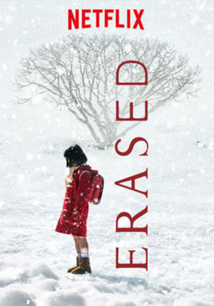 Erased
ErasedJapanese Title: 僕だけがいない街
Suspense. Murder. Time travel. This epic Netflix Original is based on the manga by Kei Sanbe. It follows a manga artist (漫画家, mangaka, in Japanese) with the ability to travel back in time and stop fatal accidents from occurring. When his mother is murdered, he travels back in time where he must save the lives of three children in the past, and his mother in the present.
 Million Yen Women
Million Yen WomenJapanese Title: 100万円の女たち
Based on the manga by Shunju Aono. A novelist, Shin Michima, lives with five other women who rent out space in his home. They each pay him 1 million yen every month -- much higher than necessary -- under the condition that no questions are ever asked about the women. But what are they hiding? This rom-com mystery stars Yojiro Noda from the band RADWIMPS.
 Switched
SwitchedJapanese Title: 宇宙を駆けるよだか
In a Freaky Friday-esque scenario, popular Ayumi and her unpopular classmate Umine suddenly change bodies on the day of Ayumi’s big date with a close friend. However, no one believes her, and Umine refuses to switch back. Now, Ayumi must find a way to get her body back.
 Perfect Crime
Perfect CrimeJapanese Title: パーフェクトクライム
If you’re a fan of “Terrace House,” you’ll recognize the female lead in this show as Triendl Reina! She plays Kaori, an interior designer, who is having an illicit affair with her married boss. Her new work partner, Haruto, catches them one day. Is Kaori’s fate sealed or will it change for the better?
 Samurai Gourmet
Samurai GourmetJapanese Title: 野武士のグルメ
A retired salaryman discovers the joy in having time on his hands and day drinking. It brings out his fantasy inner persona -- a wandering samurai -- who inspires him to eat and drink freely and discover amazing food.
 Good Morning Call
Good Morning CallJapanese Title: グッドモーニングコール
High schooler Nao is renting her dream apartment, but she’s surprised to discover she’s sharing it! And with her popular, handsome classmate Hisashi, no less. They realize they’ve been scammed and both leased the apartment, but they come to an agreement to live together and split the rent… But no one must find out! Cue typical rom-com misadventures and romance in this cute drama.
 Atelier
AtelierJapanese Title: アンダーウェア
Set in the Ginza district in Tokyo (which is the fancy, high-end shopping area), Mayuko begins working at a small, upscale lingerie shop called Emotion. It’s owned by the thorny Mayumi Nanjou, who is trying to keep her shop going while refusing to compromise her style of single-production items. Mayuko struggles to fit into her new work environment, in a very “The Devil Wears Prada” setting.
 The Many Faces of Ito
The Many Faces of ItoJapanese Title: 伊藤くん A to E
In this romantic comedy, a rom-com screenwriter tries to get fuel for her screenplay by tricking four women into sharing their real-life stories. As it turns out, all four women are in love with a man named Ito. Discovering this similar thread in each story, she digs deeper to discover the truth as to who Ito really is.
 Hibana: Spark
Hibana: SparkJapanese Title: 火花
An unpopular stand-up comedian, Tokunaga, is trying to make it big as a Manzai comedy style. Manzai is a style of comedy where a duo uses puns and misunderstandings to shoot off many jokes in a silly manner. Tokunaga meets another experienced Manzai comedian, Kamiya, who takes him under his wing as an apprentice and inspires his creativity.
 Your Home is My Business! Counterattack
Your Home is My Business! CounterattackJapanese Title: 家売るオンナの逆襲
Literally translated as “Counterattack of home-selling woman”, this drama stars popular actors Keiko Kitagawa and Shota Matsuda. Leading up to the 2020 Tokyo Olympics, real estate in Tokyo has skyrocketed. Real estate agent, Machi, uses her unique method of being too involved in her clients’ lives in order to always make a sale and outsell her competitors.
 Final Fantasy XIV: Dad of Light
Final Fantasy XIV: Dad of LightJapanese Title: ファイナルファンタジーXIV 光のお父さん
Based on a heartwarming true story, Akio hatches a plan to reconnect with his dad through Final Fantasy. He secretly interacts with him online in game, to find out why his dad has withdrawn and quit his job.
 99.9: Criminal Lawyer
99.9: Criminal LawyerJapanese Title: 99.9-刑事専門弁護士-
Starring Jun Matsumoto of the popular band Arashi, he plays lawyer Hiroto Miyama. He seeks justice and truth for the innocents against Japan’s 99.9% conviction rate. However, he can’t seem to make any money in his cases… And then he’s approached by a big-time law firm.
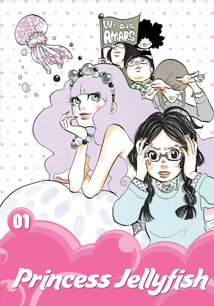 Princess Jellyfish
Princess JellyfishJapanese Title: 海月姫
Based on the famous manga series, Princess Jellyfish is about a young woman whose shyness and awkwardness keep her from pursuing her dreams of becoming an illustrator. She lives among otaku women and is obsessed with jellyfish because of memories with her deceased mother. Happenstance thanks to a jellyfish leads her to new people, new opportunities, and changes in her life.
The Best ICYMI Japanese Dramas
Still looking for more awesome dramas to watch? Well here’s your ICYMI (in case you missed it) list. If you haven’t seen these favorites listed below, then it’s time to go back and watch them! These series are iconic, cult classics, and rom-com favorites. Take note, too: this was the era of Oguri Shun, who pretty much starred in everything in the early 2000s.
Hana Yori Dango (花より団子)
Gokusen (ごくせん)
Mischievous Kiss: Love in Tokyo (イタズラなKiss~Love in Tokyo)
Sailor Uniform and Machine Gun (セーラー服と機関銃)
1 Liter of Tears (1リットルの涙)
Song of the Sun (たいようのうた)
JIN (JIN-仁-)
Absolute Boyfriend (絶対彼氏)
Bambino! (バンビーノ!)
Rich Man, Poor Woman (リッチマン、プアウーマン)
Hanazakari no Kimitachi e (花ざかりの君たちへ)
Get on Netflix and Learn Japanese!
There you have it -- all the best Japanese dramas to get started watching and learning. Plus, tips for how to transform your Netflix addiction into an active study session to master Japanese!
Ready to learn more? Learn the 101 core Japanese words to pick out the most in every conversation (or show!), fast.
And, if you want even more listening practice, why not try podcasts? JapanesePod101 is my favorite for learning Japanese at any level, with fun and engaging topics. Read more about how to use podcasts to learn a language.
What’s your favorite, binge-worthy Japanese drama? Share it in the comments!
The post The 24 Best Japanese Dramas to Binge and Learn Japanese appeared first on Fluent in 3 months - Language Hacking and Travel Tips.




September 22, 2019
Russian Greetings: 15 Ways to Say “Hello” in Russian

Здравствуйте - zdravstvuyte
How can something so basic, have four consonants following each other?
It’s like the language version of military training. It’s meant to test your willpower, reserve, endurance, and only allow those who really want to finish the program. And it’s just the start!
The program here, of course, means learning how to speak Russian.
If you can make peace with the fact that the answer to a simple question, ‘how do you say “hello” in Russian?’, isn’t as easy as you’d expect it to be, you’ve passed the first trial.
But for those who aren’t ready yet, it’s a good idea to look into 15 alternative Russian greetings.
Curious? Let’s find out what these basic Russian phrases are!
Russian Greetings
The Merriam Webster dictionary defines a greeting as a salutation at meeting. Just like in English, you can say the following Russian greetings whenever you meet a Russian person.
Be aware: the Russian language has a high level of politeness. So some greetings are better used for your close friends, where others are only good in specific (formal) situations.
Don’t worry though. After every greeting I’ll quickly discuss what it means (literal meaning & English equivalent) and in which situations you can use it.
1. “Hi” in Russian - Привет (privyet)
After trying to pronounce the tongue twister здравствуйте, you’d do better and switch to this simple way of saying “hi” in Russian. It’s easy to say and chances are you’ll get it right on your first or second try.
Even though it’s officially considered an informal way of saying hello, you can get away with in many cases. For example, saying “hi” to friends, family, or even casual acquaintances. If you’re unsure though, I recommend you only say it to those that you’d otherwise address with the informal “you” (ты).
*The great thing about being a foreigner in Russia, is that you have much more leeway with getting the formality (or anything, really) right. As people know it’s not your native language, they’re quick to forgive little mistakes. *
When I’m in Russia, I basically make привет my default greeting. Unless I’m in the following situations:
Officials such as police, customs officers or security guards
Elderly people
Anyone who’s doing their job (waiters, store clerks, taxi drivers, etc.)
Or if I’m in a bigger group and am unsure what the formality level is
In any of those cases, you’re better of doing some mouth gymnastics and saying….
2. “Hello” in Russian - Здравствуйте (zdravstvuyte)
Look, the first thing that you absolutely must know before even trying to pronounce this greeting is that *virtually every Russian person skips the first ‘в’ and softens the ‘c’ to more of a ‘z’ sound. *So instead of four consonants, you actually only have to pronounce three.
This makes it a lot easier (still not easy though!).
Try saying it: Zdraztvuytye
How did that go? Better, right? Good. Don’t worry about perfect pronunciation at this point. Just know that it will get better over time, as you improve your ability to say multiple consonants right after each other.
As far as the use is concerned, it’s a great greeting to use in every situation where you’d otherwise use the formal “you” (Вы) in Russian.
Здравствуйте is the formal command of the verb здравствовать - which means “to live long”. So when you say здравствуйте, you command them to live well and long. Over time the meaning has switched to only hello, but it’s nice to know where it comes from as few foreigners will know this.
Still find it hard to pronounce? Then you’ll love the next greeting.
3. An Informal “Hello” in Russian - Здрасте (Zdraste)
Sometimes I get the feeling that even Russians find здравствуйте a little over the top and too long for a regular greeting.
That’s why you’ll often hear the shortened version of it: Здрасте.
If you’d repeat Здравствуйте 20 times as fast as you can, you quickly notice that you drop the вы in the middle of it. And you’re left with an even shorter (and way easier on the tongue) way of saying “hello”.
As far as the usage and formality is concerned, I’d say it’s somewhere in between здравствуйте and привет. You often hear this greeting when someone says “hi” to a small group of people (five or so), and still wants to say hello to each individual.
4. A More Affectionate “Hi” in Russian - Приветик (privyetik)
If you’ve been learning Russian for a while, you’ll know that you can ‘cutify’ almost every word by adding a suffix. One of them is “ик”, and it works well to add to привет. You can hear kids saying this, or sometimes an adult to kids.
I don’t really recommend foreigners to use this mini version of привет, since it’s tough to get its usage right. Saying it to adults can get you some weird looks. So if you’re going the informal route, just stick to the tried and true привет.
5. A Russified “Hello” - Алло / Алё / Элло (Allo / Alyo / Ello)
This one shouldn’t come as a surprise, as I’m sure you’ve heard Russians speak English before, right? You simply take the English “hello” and say it with a Russian accent.
The catch?
If you try to say this as a foreigner, 80% chance it will look as if you’re making fun of the Russian accent.
So don’t say this.
6. “Hey” in Russian - Здорого (Zdorovo)
This is another trap in the land of Russian greetings (don’t worry, we’ll get to more safe words starting in a moment). When pronouncing this informal greeting, be sure to put the stress on the second o. When the stress is on the first o, it means “nice” or “well done”. So keep this in mind to avoid weird situations, where someone tells you “nice, good job”, and you respond by saying “hi”.
7. “Good Morning” in Russian - Доброе утро (dobroye utro)
We’re back in safe territory. “Good morning” in Russian literally means “kind morning”. The Russian word for morning (утро), is neuter gender, so the adjective should also be in the neuter form.
It’s easy to recognize this, as every word that ends in “е” or “о” is neuter. And the adjective takes these two letters to form the ending. If you want to learn more about this, you can check out this guide to Russian noun genders. As “good day” and “good evening” also follow this adjective plus noun combination.
As you’d expect, you can say доброе утро, every time when it’s morning, or when you just woke up.
Russian culture tip: if you’re a guy, then it’s custom to shake hands in the morning with other guys. So remember this if you’re staying over at someone's place.
Russian culture tip 2: never ever shake hands over a doorway. This is considered a bad omen in Russia.
8. “Good Day” in Russian - Добрый день (dobriy den)
Again, this literally means “kind day”. You can say this approximately from 12pm until 6pm. The word for day (день) is masculine, so the adjective should follow suit.
9. “Good evening” in Russian - Добрый вечер (dobriy vecher)
Nothing new here. It literally means “kind evening”. You can use it after 6pm.
10. “Goodnight” in Russian - Доброй ночи (dobroy nochi)
I was doubting whether to include this here, as it’s not really a Russian greeting. Just like in English, “goodnight” in Russian is more often used to wish someone a good night of sleep. Even if you’d meet someone late at night, you’re better off saying добрый вечер (“good evening”).
Also notice that Доброй ночи, is not in the nominative case, as with the previous three greetings. This is because often when you’re wishing something to someone, you put the thing you wish in the genitive case.
11. “Welcome” in Russian - Добро пожаловать (dobro pozhalovat’)
If you’ve ever been to Russia, you’ve seen this every time you enter a city, region or village. It’s a formal way of saying “welcome”, but you can use it in any informal situation as well. Literally, it means something along the lines of “kind staying”. So you wish someone a kind stay, you can say these words.
12. “Welcome” (After a Long Journey)- С приездом (S priyezdom)
You probably don’t need to say this, but do expect to hear it said to you. Even though it’s best translated as “welcome”, it’s literally a form of congratulations and means “[congratulations] with arrival”. Приезд is used here in the instrumental case, as the preposition is “с” (with), which always triggers this case.
13. “Welcome” (After a Flight) - С прилётом (S prilyotom)
This expression is the same as “С приездом”, but it’s used if you arrive by plane, as прилёт means flight arrival.
14. Military “Hello” in Russian - Здравия желаю (Zdraviya zhelayu)
This is the military way of saying “hello” in Russian. You won’t need to say this as a foreigner, but it’s good to know. If you know someone really well, you could even say it as a joke to them.
15. “Hello” (After a Long Absence) - Сколько лет, сколько зим! (Skol’ko let, skol’ko zim!)
This greeting is likely the last one that a Russian person would expect from a foreigner. If you haven’t seen someone for a very long time, you can say “how many summers, how many winters”, to signify how many years it has since you’ve last seen each other.
As you can probably tell, this is an informal greeting!
What’s Your Favourite Russian Greeting?
So how about you? Have you traveled to Russia before and noticed some specific greetings not on this list?
Russian is a creative language, and there are hundreds of ways to greet someone. There are countless of words not on the list. What are your favorite greetings in Russian? Let me know in the comments!
The post Russian Greetings: 15 Ways to Say “Hello” in Russian appeared first on Fluent in 3 months - Language Hacking and Travel Tips.




September 19, 2019
How to Learn the Japanese Alphabet (With Japanese Alphabet Charts)

I agree, that’s pretty scary!
Here’s the thing. Japanese is not as hard as you think -- in fact, you can learn Japanese, fast.
One of the best ways to start studying is to learn the basics of reading and writing in Japanese. After all, these are part of the four main skills you need to reach fluency!
And despite what you might think, learning the difference between the Japanese writing systems and understanding the basics are quite simple. In fact, you could learn it in a day if you tried!
Here’s everything you need to know about the Japanese alphabet to get started.
I’ll start by answering questions that language learners often ask about why Japanese is written the way it is.
What are the Letters of the Japanese Alphabet?
The Japanese alphabet actually contains fewer letters than the English alphabet!
When Romanizing Japanese (that is, writing Japanese words with English letters, also called romaji), you will only use the vowels a, i, u, e, o. And you’ll use these consonants: k, g, s, z, j, t, d, n, h, f, b, p, m, y, r, w. There is also the combined letters ch -- the letter “c” is never used on its own. That’s 21 letters in total.
The sounds in the Japanese alphabet are one thing that makes Japanese easier for English speakers to learn than for Japanese speakers to learn English.
Japanese contains almost no new sounds for English speakers, whereas English has many sounds not found in Japanese. The main sound that English speakers struggle with is the Japanese “r.” It’s pronounced between an “l” and an “r”, almost like the soft “r” sound from Spanish. Say “la, la, la” and notice where your tongue flicks off from behind your teeth. Now say “da, da, da.” This spot where your tongue touches the roof of your mouth is actually where you flick off from to create the “r” sound in Japanese!
How Many Letters are in the Japanese Alphabet?
There are 46 basic characters in the Japanese alphabet and additional characters/sounds that can be made from the basic 46. Each of the alphabet symbols forms one syllable made of the 21 romaji, which is phonetic and always read the same way. Because of that, reading Japanese is a great way to pick up proper pronunciation for spoken Japanese. There’s no guessing like in English, where two words that look the same sound nothing alike, or words that look nothing alike sound the same. How you read the characters in Japanese is exactly how you say it, without exception.
How does the Japanese Alphabet Work?
The Japanese alphabet is called a “syllabary,” or “syllabic script.” That’s because each “letter” in Japanese represents a whole syllable in English. There are two main ways the characters represent syllables: as a sole vowel and as a consonant with a vowel. There is only one character that represents a sole consonant: n. Other than that, consonants must always be paired with a vowel, and the vowel will always follow the consonant.
Japanese has two “alphabets” called hiragana (curvy like English cursive), and katakana (angular like English print). The two together are called kana. The third writing system, kanji, is not really an alphabet or a syllabary. Instead, it represents whole words. The three systems of writing can all be used within the same sentence. Unlike English where you’d write only in cursive or print, you can combine kana and kanji as needed.
Why are there 3 Alphabets in Japan?
Hiragana and katakana are native to Japan, while kanji was imported from Chinese hanzi. Each of the characters has its own function, though. Many words are represented by a kanji character and the sound is completed with hiragana.
An example of this is 好き (suki). The first character, 好, is the kanji and read as su. The second character, き, is a hiragana symbol that’s read as ki. They’re used together to create one word: suki, “like.”
Hiragana is also used for many other reasons. Words can be written entirely in hiragana. It can be used for furigana, small hiragana written above kanji to help with reading. Also, it can be used to write particles that mark the purpose of a noun or verb in a sentence. Writing exclusively in hiragana is okay, but makes it a bit more difficult to read. Words can get “jumbled” together because Japanese doesn’t use spaces. It’s also a bit childish to write only in hiragana -- children write exclusively in hiragana until they start learning kanji in grade school.
Kanji are used in reading and writing to make it clear what the word is referring to. For instance, hashi means both “chopsticks” and “bridge.” But when you’re writing, the kanji makes it obvious which you mean: if you write 箸, you mean “chopsticks.” And if you use 橋, you mean “bridge.” Kanji characters can have many different readings though, unlike the standardized, single reading of kana characters.
What about katakana? Well, katakana is only used for two reasons: to write foreign words in Japanese, or to put emphasis on a word. Sometimes you’ll see either slang or people’s names written in katakana to stylize or put emphasis. You’ll also see them used for Japanese onomatopoeia.
Katakana and hiragana both contain the same amount of characters that correspond to each other. What that means is, the hiragana き and katakana キ are both read as “ki.” Just like “A” and “A” in print and cursive English.
Japanese Alphabet Charts
Okay! Now, let’s take a look at the characters for each of the Japanese alphabets.
Japanese Alphabet: Hiragana
k
s
t
n
h
m
y
r
w
a
あ (a)
か (ka)
さ (sa)
た (ta)
な (na)
は (ha)
ま (ma)
や (ya)
ら (ra)
わ (wa)
ん (n)
i
い (i)
き (ki)
し (shi)
ち (chi)
に (ni)
ひ (hi)
み (mi)
り (ri)
u
う (u)
く (ku)
す (su)
つ (tsu)
ぬ (nu)
ふ (fu)
む (mu)
ゆ (yu)
る (ru)
e
え (e)
け (ke)
せ (se)
て (te)
ね (ne)
へ (he)
め (me)
れ (re)
o
お (o)
こ (ko)
そ (so)
と (to)
の (no)
ほ (ho)
も (mo)
よ (yo)
ろ (ro)
を (wo)
This type of chart, called the gojuuon, is a 50-block chart that organizes the kana sounds into something like alphabetical order. It’s always written this way. It doesn’t include the extra sounds made with dakuten (the double accent marks: ゙), handakuten (the small circle: ゚), sokuon (which is a small っ that doubles the consonant sound and makes a “stop” in the word), or yoon (the small Y-row characters: ゃ,ゅ,ょ). These are special characters added on to these 46 basic sounds to make the additional sounds in Japanese.
For instance, adding the dakuten to き makes it ぎ (“gi”). Handakuten are only used with H-row characters, to change the sound from H to P. So, は (“ha”) becomes ぱ (“pa”).
The most common sokuon is the small っ (tsu), which is added in between characters to double the consonant of the second syllable. A common word using this is かっこいい (kakkoii, “cool”). When pronouncing it, the “k” in “ko” is given a strong accent that adds a “stop” sound to the middle of the word.
And lastly, yoon characters are the small Y-row that can combine with any of the the I-row of consonants + vowels. So, if you added や ("ya") to き ("ki"), it becomes きゃ ("kya"). If you add よ (“yo”) to ち (“chi”) it becomes ちょ (“cho”). You drop the “i” vowel and add the “ya/yu/yo” to the consonant, except for “chi” and “shi”. These two sounds become “cha/chu/cho” and “sha/shu/sho” when you add yoon characters.
It’s a lot to take in at first, but I promise it makes sense quickly! The more you read the characters, the easier it is to understand and see the patterns. Start with the basic 46. Get comfortable with those symbols and sounds. Then start to memorize the additional sounds and how to properly write them.
Japanese Alphabet: Katakana
k
s
t
n
h
m
y
r
w
a
ア (a)
カ (ka)
サ (sa)
タ (ta)
ナ (na)
ハ (ha)
マ (ma)
ヤ (ya)
ラ (ra)
ワ (wa)
ン (n)
i
イ (i)
キ (ki)
シ (shi)
チ (chi)
ニ (ni)
ヒ (hi)
ミ (mi)
リ (ri)
u
ウ (u)
ク (ku)
ス (su)
ツ (tsu)
ヌ (nu)
フ (fu)
ム (mu)
ユ (yu)
ル (ru)
e
エ (e)
ケ (ke)
セ (se)
テ (te)
ネ (ne)
ヘ (he)
メ (me)
レ (re)
o
オ (o)
コ (ko)
ソ (so)
ト (to)
ノ (no)
ホ (ho)
モ (mo)
ヨ (yo)
ロ (ro)
ヲ (wo)
The katakana chart is laid out exactly like the hiragana chart, as they coordinate with each other. New learners often have a hard time memorizing katakana, especially because some characters look very similar, like ツ (tsu) and シ (shi). How to tell them apart is all about the direction of the strokes when writing it. Tsu is written top down, while shi is written left-to-right.

If you’ve learned all the extra sounds and accents with hiragana, you’ll have no problem learning them with katakana as well.
Japanese Alphabet: Kanji
Now let’s look at kanji. Kanji is totally different than hiragana and katakana, because it’s not an alphabet system. Each character has a whole-word meaning and combine with other kanji to create compounds and deeper meanings. There are thousands of kanji, and around 2,000 that are considered essential for everyday reading and writing. But these 100 are a great place to start and get a feel for kanji.
Kanji
English Meaning
Onyomi
Kunyomi
JLPT N5 Vocab with Kanji
一
One
ichi, itsu
hito(tsu), hito
一人 (one person, alone)
二
Two
ni
futa(tsu), futa
二人 (two people, pair)
三
Three
san
mit(tsu), mi
三日 (3rd day of the month)
四
Four
shi
yo(tsu), yo, yon
四日 (4th day of the month)
五
Five
go
itsu(tsu), itsu
五日 (5th day of the month)
六
Six
roku
mut(tsu), mu
六日 (6th day of the month)
七
Seven
shichi
nana(tsu), nana
七日 (7th day of the month)
八
Eight
hachi
yat(tsu), ya
八日 (8th day of the month)
九
Nine
kyuu, ku
kokono(tsu), kokono
九日 (9th day of the month)
十
Ten
juu, ji
tou, to
十日 (10th day of the month)
百
Hundred
hyaku
---
百万円 (1 million Yen)
千
Thousand
sen
chi
千万円 (10 million Yen)
万
Ten thousand
man, ban
---
万年筆 (fountain pen)
円
Yen, circle, and round
en
maru(i)
円い (round)
日
Day, sun
nichi, jitsu
hi, ka
明日 (tomorrow)
週
Week
shuu
---
毎週 (every week)
月
Month, moon
getsu, gatsu
tsuki
月曜日 (Monday)
年
Year
nen
toshi
今年 (this year), 去年 (last year)
時
Time, hour
ji
toki
時計 (clock, watch)
間
Time frame, span of time
kan, ken
aida
時間 (time, hours)
分
Minute, part, to understand, to divide
bun, bu, fun
wa(karu)
三十分 (thirty minutes), 自分 (oneself)
午
Noon
go
---
午前 (morning, A.M.)
前
Before
zen
mae
名前 (name)
後
After, later, behind
go, kou
ato
午後 (afternoon, P.M.)
今
Now
kon, kin
ima
今晩 (this evening), 今朝 (this morning)
先
Before, ahead, future
sen
saki
先週 (last week), 先生 (teacher, master)
来
To come
rai
ku(ru)
来月 (next month), 来る (to come)
半
Half, middle
han
naka(ba)
半分 (half)
毎
Every, each
mai
---
毎日(every day)
何
What, which, how many
ka
nan, nani
何曜日 (what day of the week)
人
Person
jin, nin
hito
人々 (people)
男
Man, boy, male
dan, nan
otoko
男の子 (boy)
女
Woman, girl, female
jo, nyo
onna, me
女の子 (girl)
子
Child
shi, su
ko
子供 (child)
母
Mother
bo
haha
母 (mother)
父
Father
fu
chichi
父 (father)
友
Friend
yuu
tomo
友達 (friend)
火
Fire
ka
hi
火曜日 (Tuesday)
水
Water
sui
mizu
水曜日 (Wednesday)
木
Tree, wood
moku, boku
ki, ko
木曜日 (Thursday)
土
Earth, ground
do, to
tsuchi
土曜日 (Saturday)
金
Money, gold
kin, kon
kane
金曜日 (Friday)
本
Book, source
hon
moto
日本語 (Japanese)
川
River
sen
kawa
川 (river)
花
Flower
ka
hana
花火 (fireworks)
気
Spirit
ki, ke
---
元気 (healthy, spirit, fine)
生
Life, to live, to be born, to grow
sei, shou
i(kiru), u(mareru), ha(yasu)
生徒 (pupil)
魚
Fish
gyo
sakana
魚 (fish)
天
Heaven
ten
ame, ama
天気 (weather)
空
Sky, empty
kuu
sora, a(keru)
空 (sky)
山
Mountain
san
yama
山 (mountain)
雨
Rain
u
ame
雨 (rain)
電
Electricity
den
---
電気 (electricity)
車
Car, vehicle
sha
kuruma
電車 (electric train)
語
Language, word, to chat
go
kata(ru)
英語 (English)
耳
Ear
ji
mimi
耳 (ear)
手
Hand
shu
te
手紙 (letter)
足
Foot, to add
soku
ashi, ta(su)
足 (foot)
目
Eye
moku
me
目 (eye)
口
Mouth
kou, ku
kuchi
出口 (exit)
名
Name
mei, myou
na
名前 (name)
店
Shop
ten
mise
喫茶店 (coffee shop)
駅
Station
eki
---
駅前 (in front of the station)
道
Street, path, way
dou
michi
道具 (tool)
社
Shrine, society
sha
yashiro
社長 (president of a company)
国
Country
koku
kuni
外国人 (foreigner)
外
Outside
gai, ge
soto, hazu(reru), hoka
外国 (foreign country)
学
School, learning
gaku
mana(bu)
大学 (university)
校
School
kou
---
学校 (school)
上
Up, above
shou, jou
ue, u, a(geru)
上着 (jacket)
下
Down, below
ka, ge
ku(daru), shita
靴下 (socks)
中
Middle, center, inner, between
chuu
naka
日中 (during the day, midday)
北
North
hoku
kita
北 (north)
西
West
sai, sei
nishi
西 (west)
東
East
tou
higashi
東京 (Tokyo)
南
South
nan
minami
南 (south)
右
Right
yuu
migi
右 (right)
左
Left
sa
hidari
左 (left)
見
To see, to be visible, to show
ken
mi(ru)
見せる (to show)
聞
To hear, to listen, to ask
mon, bun
ki(ku)
聞く (to listen, to hear)
書
To write
sho
ka(ku)
辞書 (dictionary)
読
To read
doku
yo(mu)
読む (to read)
話
To talk, conversation
wa
hanashi, hana(su)
電話 (telephone)
買
To buy
bai
ka(u)
買い物 (shopping)
行
To go, to carry out
kou
i(ku), okona(u)
銀行 (bank)
出
To go out, to leave
shutsu
de(ru), da(su)
出かける (to go out)
入
To enter, to put in
nyuu
hai(ru), i(reru)
入口 (entrance)
休
To rest, break, holiday, vacation
kyuu
yasu(mu), yasu(mi)
休む (to take a day off)
食
To eat, food
shoku
ta(beru)
食堂 (dining room)
飲
To drink, a drink
in
no(mu)
飲み物 (beverage)
言
To talk, word
gen, gon
i(u)
言う (to say)
立
To stand
ritsu
ta(tsu)
立つ (to stand)
会
To meet, society
kai, e
a(u)
会社 (company)
多
A lot, many
ta
oo(i)
多い (many), 多分 (probably)
少
A little, few
shou
suko(shi), suku(nai)
少ない (few)
古
Old
ko
furu(i)
古い (old)
新
New
shin
atara(shii)
新しい (new), 新聞 (newspaper)
大
Big, a lot
dai, tai
oo(kii)
大きい (big), 大変 (dreadful, immense)
小
Little, small
shou
chii(sai), ko
小さい (little)
安
Cheap, safety, peace
an
yasu(i)
安い (cheap)
高
Expensive, high
kou
taka(i)
高い (expensive)
長
Long, leader
chou
naga(i)
長い (long), 部長 (manager)
白
White
haku, byaku
shiro, shiro(i)
白い (white), 面白い (interesting)
As you can see, each kanji has multiple readings. This is what makes it hard to learn how to read. The readings change based on the word or how it combines with other kanji. The easiest way to learn how to read them? When you’re learning your kanji, also memorize a common word for each reading. It helps lock in the sounds and meaning at the same time.
But don’t stress about kanji too much. Just look over the chart and get a feel for what these characters look like and represent. Learn your kana first, the true Japanese alphabet system. Then, move on to kanji.
What is the Most Common Japanese Alphabet?
The honest truth is that all three alphabets are common. You need to learn all your kana and some kanji to get by. That said, you could get by writing only in hiragana. Hiragana is the most “basic” and the first writing system that children learn, so it can be used to convey the same ideas as you would using all three systems. Although you’ll be understood, be aware that it would appear very childish.
My advice? Master both hiragana and katakana completely, and learn at least 100 essential kanji.
Is Japanese read Right-to-Left or Left-to-Right?
So… how do you read Japanese? The honest truth is… it’s both. Traditionally, and especially in literature, you’ll see Japanese written in vertical lines. These lines are read top to bottom, right-to-left. The characters are stacked single file in these vertical lines and there are no spaces. So it takes a bit of practice to get used to this style. However, I find this way of writing incredibly elegant. It’s worth the practice!
In modern situations, you’ll find Japanese written horizontally and read from left-to-right. Things like brand names on packages, signs, and more.
Where and when you see which way of writing varies greatly. You’ll see neon signs on buildings written vertically, while some ads may be horizontally written. The usual rule of thumb is if it’s vertically written, you read right-to-left. And if it’s horizontally written, you read left-to-right.
There are a few exceptions, but you’ll learn to spot them once you get used to reading Japanese and how it normally looks.
Tips for Learning the Japanese Alphabet, Fast
There are some easy ways to learn the Japanese writing systems -- fast!
The best tip is to come up with mnemonic devices to remember them. Here are some examples of ways I remember the hiragana:
ぬ (nu) looks like chopsticks grabbing a ramen noodle
む (mu) kind of looks like a cartoon cow face -- moo
し (shi) looks like a hook for catching fish in the sea/shi
に (ni) looks like a knee!
れ (re) looks like a person running. Think like Scooby Doo: “Ret’s get out of here!”
み (mi) looks like a fancy script for “21.” So I remember the phrase, “As for me, I’m 21.” (Not really, but it still helps!)
き (ki) looks like an old fashioned key
め (me) looks like an Olympic gold medal
つ (tsu) looks like a wave from a tsunami
ひ (hi) looks like a smile, hee hee hee
Those are just some examples of my own mnemonics I’ve used to learn and remember the hiragana. You can do the same thing for katakana and kanji, too!
Another way to practice and memorize is to write out the gojuuon chart and fill it in yourself. I used to do this over and over for both hiragana and katakana. I write the vertical row with the vowels, and the horizontal row with the first letter of the consonants. Then I work on filling in each row’s symbols. Any I can’t remember, I leave blank. Then I look over the chart, check for mistakes, and write in any I forgot. I did this until I memorized them all! And it’s great writing practice. Pro tip: the gojuuon chart is actually really helpful for learning basic verb conjugation. So memorizing the way the chart flows can help you with grammar, too!
As for kanji, I highly recommend using Heisig’s method and Anki. This method is very similar to the one I described for kana, but it focuses on learning the character and English description first, and then going back to learn the readings later with related vocab. It’s a very effective method, and one of the most popular among Japanese learners.
The Japanese Alphabet is Easy!
Seriously -- it is! Even if you’re still a little confused or overwhelmed right now, it clicks together fast with just a bit of practice. Using mnemonic devices can help you memorize the kana in only one day’s study time!
What other tips do you have for learning the Japanese alphabet/syllabary? Are there certain characters you struggle with? Leave a comment and let me know!
The post How to Learn the Japanese Alphabet (With Japanese Alphabet Charts) appeared first on Fluent in 3 months - Language Hacking and Travel Tips.




September 15, 2019
German Colors: A Fun and Easy Way to Learn Colors in German

Since German is a close cousin of English, most German color words are very similar in spelling and pronunciation to their English counterparts. This means you won't have to do much work to remember them.
The word "color" itself (although Irish folk like me would spell it "colour"!) translates as the feminine noun Farbe (plural Farben). If you ever get stuck trying to remember a color word, try asking somebody welche Farbe ist das? - "what color is that?"
Farbe also shows up in words like farblos (“colorless”), farbenfroh (“colorful”), and farbenblind (“colorblind”), and can be used as a prefix (Farb-) in compound nouns like Farbfernseher (“color television”).
Below, I'll teach you all the most important color words in German. We'll also cover some colorful idiomatic expressions, such as blau sein (“to be blue”), which doesn't mean the same thing as "to feel blue" in English. But first, a few quick notes on grammar:
First, remember that German colors, when used as adjectives, follow all the same rules as regular adjectives. A full description of German adjective rules is beyond the scope of the article, but the most important point is that the color words must agree with the noun in gender and case: ein weißes Hemd (a white shirt) but "ein weißer Rock" (a white skirt).
The exception is color words that end in -a, like rosa, or lila. These words don't take any special endings: it's ein rosa Hemd or ein lila Rock.
In some situations, German color words can function as nouns. This means that, like all German nouns, they should be written with a capital letter; for example, das Blau des Himmels (“the blue of the sky”). When used as a noun, German colors always take the neuter gender, i.e. they use "das".
Want to learn German fast? Then check out our favourite German course, GermanPod101. It includes fun, easy to follow lessons on German colors.

With that out of the way, let's look at what the actual color words are:
How to Say "Red" in German
"Red" in German is rot. Unless you've been drinking too much Rotwein (“red wine”), this rotten word isn't hard to remember.
Rot sehen, "to see red", has the same meaning as in English: to be very angry. It can also mean "to be a shown a red card", as in football.
German children are also familiar with the story of Rotkäppchen (literally "little red cap"), who is better known to English audiences as Little Red Riding Hood.
How to Say "Blue" in German
"Blue" in German is blau. It rhymes with the English word "now". Policeman have a Blaulicht (“siren”, or literally "blue light") on their cars, and when you're designing something you might use a Blaupause (“blueprint”).
In English, to “feel blue” means that you're sad. In German, however, if you describe someone as blau, it means that they're drunk! Another difference from English is that, if someone punches you in the face, they can give you a blaues Auge ("blue eye"), not a "black eye".
That last one shouldn't to be confused with the adjective blauäugig, "blue-eyed". Someone who is blauäugig is naïve*.
On the other hand, saying that someone has blaues Blut ("blue blood") has the same meaning as in English; it means they're part of the nobility.
How to Say "Green" in German
"Green" in German is grün, pronounced (roughly) "groon". Die Grüne, "The Greens", is also the name of a German political party.
Like in English, you can give someone permission or approval by giving them the grünes Licht ("green light”). My own home country, the so-called Emerald Isle, is colloquially known in German as die Grüne Insel ("the green island").
You can also say that something ist dasselbe in Grün - "it's the same in green". This is a, ahem, colorful way of saying that "it's the same" or "it makes no difference" - sort of like the English expression, "it's six of one and half a dozen of the other."
You’ve probably heard the English saying, "to beat somebody black and blue", meaning to beat someone up really badly. In German they say jemanden grün und blau schlagen - to beat somebody green and blue.
How to Say "Yellow" in German
"Yellow" in German is gelb. This is one of the few German color words that looks nothing like its English translation. If it helps, remember that gelb sounds somewhat like gold, and gold is yellow.
(Incidentally, the word "gold" in German is Gold. That was easy! Silver in German is Silber.)
In English, if someone is feeling jealous, we describe them as being "green with envy". In German, you'd say they are gelb vor Neid - "yellow with envy"!
How to Say "Orange" in German
"Orange" in German is orange. This one should be very easy to remember! It's just pronounced a bit differently: "oh-RAN-shuh".
Unsurprisingly, "Orange" in German refers to the fruit as well as the color. Just don't forget that the name of the fruit, since it's a noun, must be capitalised.
Here's a fun fact - did you know that , and not the other way around? This is true in both English and German.
How to Say "Pink" in German
"Pink" in German is rosa. It's easy to remember: just think of a pink rose.
In recent years, the English loanword pink has also become common in German-speaking countries; however, in German, Pink and Rosa aren't quite the same color. Pink can be thought of as a particular shade of Rosa; Wikipedia describes it as "a strong, heavy pink" that "rarely occurs in nature." Think the garish, flashy pink used for girls' toys. If in doubt, it's probably best to stick with Rosa.
A German expression using the word rosa is durch die rosa Brille schauen, "to look through pink glasses." Someone who looks through rosa Brille has a "rosey-eyed" outlook on things; they're optimistic and see the good side.
How to Say "Purple" in German
"Purple" in German is lila. Just think of the English word "lilac" (although this flower is known in German as Flieder.)
Less commonly, you might hear violett instead. There’s also the words purpurn and purpurrot - obvious cognates of the English "purple", but considered rather old-fashioned in German these days.
How to Say "Grey" in German
"Grey" in German is grau - another one that should be easy to remember.
Someone with grey hair is said to be grauhaarig in German. The process of becoming grauhaarig is called grau werden - turning grey. If you're in a morally or legally ambiguous situation, you're in a Grauzone, a "grey area". To resolve the dilemma, you may have to rely on your graue Substanz - grey matter, i.e. your brain.
How to Say "Black" in German
"Black" in German is schwarz. This word makes me think of Arnold Schwarzenegger! If something is very dark you might call it pechschwarz (“pitch black”) or even kohlrabenschwarz (“black as a raven”).
Schwarz turns up in many expressions and compound words in German, such as der Schwarzmarkt (“the blackmarket”) or eine schwarze Liste (“a blacklist”). An estranged or troublesome family member can be described as the schwarzes Schaf (“black sheep”) of the family.
A Schwarzfahrer ("black rider") is someone who sneakily rides the train or bus without a ticket - common in cities like Berlin, where the metro stations have no turnstiles. A Schwarzseher ("black looker") is someone with a dark and dismal attitude to things -. a pessimist.
If you're very angry -- even angrier than rotsehen -- you can sich schwarz ärgern, "turn black with anger". This expression is particularly used when you're angry about something you have no control over.
How to Say "White" in German
"White" in German is weiß. Remember that the "ß" character is pronounced like an "s", so this word sounds just like the English word "vice".
A rather gory expression using weiß is weißbluten, literally "to white-bleed". Its meaning is roughly equivalent to the English expression "bleeding someone dry",or to use up all of someone's money or to extort them.
If someone is innocent, you can say that they haben eine weiße Weste - they "have a white vest". This evokes images of fairy tales or classic Western movies where the protagonists always wear white and the bad guys wear black. Someone wearing a white vest must be one of the good guys, right?
How to Say "Brown" in German
"Brown" in German is braun. It's pronounced almost identically to the English word; you just need to make sure you pronounce the "r" in the German way, from the back of your throat.
The verb bräunen means "to become brown", or to tan.
Braun is also a very common German surname, much like "Brown" is in English. The same is true of Weiß and Schwarz, just like "White" and "Black" in English-speaking countries.
Over to You!
That covers all the most common color words in German!
One final thing - if you want to talk about a lighter or darker shade of a color, use hell (“light”) or dunkel (“dark”). They combine with the adjective to create a compound word: for example hellbraun means "light brown" and dunkelblau means "dark blue".
Is there anything I've missed? Do you have any good mnemonics or tricks for remembering German color words? What are your favourite colorful idioms in German? Let us know in the comments.
The post German Colors: A Fun and Easy Way to Learn Colors in German appeared first on Fluent in 3 months - Language Hacking and Travel Tips.




September 12, 2019
The Best Way to Learn a Language Fast. It Works!

*It wasn’t her first time in this room… *
She was sweating. Every time she was in that room, she had repeated her actions: no movement, no eye-contact, no words… but this time, something interesting happened!
‘Enough!’ – she screamed like a fox trapped in a hole. Such an angry sadness!
‘I want to learn Alienish NOW!
Suddenly, an alien showed up by her side and started talking.
Wow! What a miracle! She even understood the alien’s speech! I wish I could learn an alien language just as quickly as she did! But I would be content with a foreign language too!
How did she do it?
It’s a riddle! But I certainly know what they were talking about! Listen and observe!
Alien: ‘Lucy entered the room. Did Lucy enter the room?’
Lucy: ‘Yes, Lucy entered the room.’
Alien: ‘Who entered the room?’
Lucy: ‘Lucy entered the room.’
Alien: ‘Where did Lucy enter?’….
The rest of the conversation is lost in the room. But you may imagine how it went on! ☺
The Biggest Secrets About Language Learning
This short story contains the biggest secrets about language learning! Or any learning, actually. Let’s discover these secrets together. (By the way, what I am doing now with you, is an extremely efficient method for learning anything quickly. Simply put, the tutor guides you and you draw your own conclusions).
I’ll guide you with some specific questions. Answer them before you look at the explanations. Take a minute and cover the story. Look only at the question. Don’t cheat! I’ll catch you, I am a teacher!
Could You Tell Me the Story in Your Own Words?
I’m sure, you could! Why? Because we remember STORIES easily!
Do you remember your favorite story when you were a child? Yes, you do! And you will do so even at 90 years old!
Let’s have a conversation!
*You: Why is this?
Me: Legends, myths, tales are transmitted by generation after generation. They will be alive in our mind forever.
You: OK! But why, why?
*Me: It’s all the fault of our limbic brain!
You: Great! I am happy to know that! …. But what is this limbic brain exactly?
“The limbic system, also known as the paleomammalian cortex, is a set of brain structures located on both sides of the thalamus, immediately beneath the medial temporal lobe of the cerebrum primarily in the midbrain. It supports a variety of functions including emotion, behavior, motivation, long-term memory, and olfaction. Emotional life is largely housed in the limbic system, and it critically aids the formation of memories.”
You: Aha! It’s clear….
Me: I know what you’re thinking. It’s not clear, is it? That’s not because you are not able to understand at this level, but because it’s too hard to follow (if you are not in the field). Whoever wrote this wasn’t aiming for you to remember this precious info for long. He or she didn’t do it with bad intentions, they simply followed the traditional way, the boring scholastic way. The way that has been banged into our minds since our first day at school.
What about this instead:
Skinny 'Shrew' was very simple-minded. And not only that! He was forgetful, selfish, cruel, and cowardly. In brief, he was very ‘inhuman’. In fact, he was a mammal. ☺ His kids couldn’t tolerate him anymore and they decided that Skinny had to evolve! They had a plan! Telling him stories with full of emotions. They repeated the stories every day. And what a miracle, his head grew! He started remembering his kids, hunting food for them too, feeling compassion and being a bit braver…
What stands out from both texts? The same thing: the limbic brain is responsible for emotions and memories and emerged in the first mammals. You learned the same, but you enjoyed the second more, didn’t you? Which one will you remember one week later? Or tomorrow? Or even one hour later?
It’s evident that the first one contains more information, but the second has a structure you can hang things on! You can up this structure with details! You know, when you have a strong base, you can build a castle on it! If your base is weak…well, the first breeze will blow it away…
Learning a language with stories is the most efficient way to learn a foreign language. But pay attention! There is a difference between one story and another! Let’s see how an effective story should look!
How Would You Describe the Story of Lucy and the Alien? Realistic or Exaggerated?
It was EXAGGERATED, right?
What do you remember more easily? Something normal or abnormal? Boring or remarkable? Realistic or exaggerated?
It’s evident that we remember things that are unusual, interesting, fascinating, even provocative. We forget easily what is usual. Think about boring, scholastic textbooks! Do you remember the dialogues at the post office, supermarket, or railway station? If you have just read them, maybe… but if it happened a month ago, you probably even forgot the topic!
I’ll show how you can transform a boring scholastic dialogue to a super-dialogue! The base is the same, but the result…
Ready?
Dialogue A: The Boring Dialogue
You: Hello! I would like to buy a kilogram of bread and a bottle of milk.
Me: Which milk would you prefer?
You: The red one
Me: Sure! 3 euros, please! Would you like a bag?
Dialogue B: Super Dialogue!
You: Hello! I would like to buy a piece of Iron Man’s heart and a barrel of milk.
Me: Which milk would you prefer?
You: The holey one.
Me: Sure! 97 Marvel coins, please! Would you like a web shooter?
See? Simple, right? We changed only few words but we made a big difference! Why should we study boring dialogs while we can use our super-power: imagination?
What Emotions Did You Have While Reading the Story?
Anxiety? Surprise? Curiosity? Other?
Whatever emotions you had, it is important that the story caused some in you. Why is that important? Because we remember EMOTIONS longer than anything else! Think about someone who surprised you! Or remember a situation when you were embarrassed! Recall a movie that made you cry!
There is even more! I have a surprise for you: top-secret!
I know, you would like to know it immediately, but I will give it to you throughout a short story.
By the way, what happened to Skinny?
In that old ancient time, when Skinny 'Shrew' was simple-minded because he had only a reptilian brain, he went out every day from his burrow. Each time he turned back, he was angry and scared. He was only happy when he was home.
Why did he go out then?
I have no idea! He was simple-minded, right? I think, this is the only ‘reasonable’ explanation.
Well, what’s more important is that he had these three emotions: anger, fear, and happiness. These three emotions are the most ancient emotions coded in our brain.
When a story makes you angry, fearful or happy, you will remember it longer than just a simple story!
Did You See, Hear or Touch the Story?
“Scared as a chicken facing the chop”
“She heard only buzz and murmurs”.
“At least she grasped it as alien.”
You have heard a thousand times that there are three types of people based on how they perceive the world. VISUAL, AUDITORY AND KINESTHETIC.
Do you know when we learn really efficiently? When all three perception models are involved in our learning plan. Obviously, you cannot ‘put’ them physically in a story, but you can insert them with words. Words are magic! The first sentence helps us imagine or ‘see’ the scene. The second one puts ‘buzz and murmurs’ in our ears. The third one lets us ‘touch’ with our hands. The most efficient stories contain all these fundamental elements.
Why Did the Alien Ask Lucy Questions?
Because QUESTIONS make us think. Questions deserve answers instinctively and our brain knows it!
How were these questions structured? In a simple way. Simple questions are good because they keep our motivation up. We like having positive feedback. If we answer a question correctly, we get positive feedback.
I am not a fan of studying grammar. It doesn’t mean I don’t study or I don’t teach grammar. I understand we have to feed our neocortex too, which is the most rational brain among the three brains (reptilian, limbic, and neocortex). The neocortex is the newest one, the modern one, the logical one. The neocortex wants logical explanations. However it also gets bored. It gets bored fast if it doesn’t get results. By memorizing grammar rules, the poor neocortex won’t get any results within a reasonable time.
But I have a shortcut for you!
We learn the grammar rules and words automatically if we answer a yes-no question or a simple question. We practically repeat the same words of the question with a little correction to make an affirmative sentence. Your neocortex will get results super-quickly.
And there is even more!
What do you think is the effect of a yes-no question or a simple question on your brain?
Your neocortex will be happy because it’s a challenge that it has to think. Your limbic brain will be happy because the satisfaction of the neocortex caused an emotion. Your reptile brain will be happy, because happiness is one of the most ancient emotions.
Do you want to learn a language quickly? Remember the recipe! Take remarkable stories, a piece of emotion, three ways of perception and mix them with simple questions!
Let’s Say Goodbye to Each Other with a Small Conversation
You: All is amazing, fantastic, and really cool! But how can I find such materials for my study?
Me: Obviously, it depends on your level. If you are a beginner, I suggest you rewrite simple dialogues as we did above. In this way, you will learn new cool words too! Actually, you can apply this exercise at all levels, but for intermediate and advanced levels, the spectrum is wider. In this case, you can read children’s books or your favorite comics. You can watch movies. You can chat with natives and tell them a fantastic story!
[Editor’s note: For learning using the techniques outlined in this article, we recommend LingQ. It has top quality reading and listening resources, in 15+ languages.]
We all are children inside. Keep your child in your brain while you study!
The post The Best Way to Learn a Language Fast. It Works! appeared first on Fluent in 3 months - Language Hacking and Travel Tips.




September 8, 2019
Spanish in 3 Months: My First Week (and Day 0 Video)
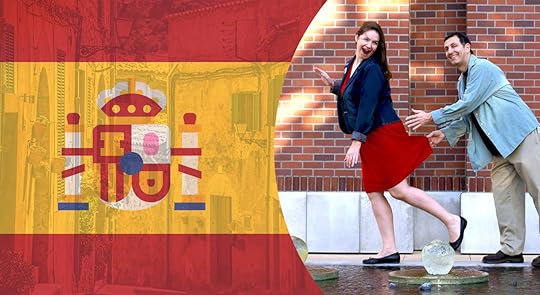
In my last article, I announced the start of my (gulp) three-month mission to learn Spanish. I talked about why I’m learning Spanish. And I shared some of my favorite tools.
Today, I’m going to share about my first week learning Spanish. My ups. My downs. My mud in the face turn arounds.
Day 1: What Have I Done?! I Realized that I Hate Spanish
Learning Spanish is not all colored pencils, glitter bombs and unicorns.
On the first official day of learning Spanish, something terrible happened. I realized that I hate Spanish. This came as an unwelcome surprise. You see, I had been daydreaming about learning Spanish for months.
After my first italki tutor session, I had a headache. So, I decided to finish the day with easy listening. I turned on a podcast that was in English but talked about Spanish. The theme song hurt my ears. And when the host spoke a few words in Spanish, I disliked his voice.
I know what you’re thinking. Just change the podcast. Well, I did. And the same thing happened. Hated the theme song. Disliked the voice.
A day later, I recorded myself speaking in Spanish to practice pronunciation. That’s when I knew I was in trouble. Even my voice sounded horrible to me in Spanish.
Panic set in. I’ve already committed publicly that I’m going to learn this new language. Will I spend three months nauseated by the sound of my own voice?
My brain was having a hard time getting accustomed to the language. So, I created a habit loop to help me through the first week. I talk about how I did that in this video.
httpvh://www.youtube.com/watch?v=UOGJOFpZYHA
After about a week of easing myself into it, I started to enjoy the sound of Spanish again. Peace was restored to my three-month mission.
To be fair, I still like the sound of French more than Spanish. That’s because French has a comfortable seat at the table in my mind. Spanish is still squeezing into my neural space. I imagine it sitting on a lopsided chair that needs a wad of napkins under one leg to make it stable.
The upside to this is that French has gone from the dreaded intermediate stage to the beloved intermediate stage. I’m relieved to speak in French now. It’s not easier but it sure feels like it.
Here’s the Kickoff Video to My Spanish Adventure
Let’s get to the nitty-gritty of my three-month Spanish mission.
Here’s my starter video. This will give you an idea of how little I know. Okay, so I admit it. I’m totally hamming it up for day 0. I couldn’t help myself. If I didn’t get silly, the video would be less than 10 seconds long as the size of my vocabulary is microscopic.
httpvh://youtu.be/1VtD4cXx8S4
How I Am Fitting Spanish into My Daily Routine
There’s one question that all my friends who want to learn a language are asking. How do you add more hours to your day?
Well, I don’t.
But I do use hidden time. That’s time for learning Spanish I didn’t know I had until I searched for it. Here are four “hidden pockets” of time I found for language learning:
1. I Wake Up Early for Spanish Lessons
I have a few online Spanish tutors, and I schedule my online Spanish lessons shortly after waking. Being a morning glory, I’ve always enjoyed my quiet routine before the house wakes up. Meditation. A big of yoga. Journaling. And now, language learning.
My computer boots up while I’m brushing my teeth. I actually don’t prep much for my lessons. To be honest, I rarely prepare at all. It’s better to have a gameplan. But if I have to be super organized about my lessons, it stresses me out.
I show up and go with the flow.
It helps that I hire teachers that are organized and flexible. I also use share documents that my Spanish Uncovered course provides as an outline for the lessons. Those notes are perfect for someone like me who doesn’t want to rehash with the tutor what I’ve covered this week.
Spending a few minutes catching up with my Fi3M Challenge buds gives me a healthy dose of “atta girl” to keep me pumped. I glance at what everyone else is doing on the daily check-in area of our online community.
This helps me feel like I’m part of a winning team. It also gives me ideas on new tools I could try. I’ll share a few of my personal check-ins a bit later.
2. I Listen to Spanish While Exercising

Full disclosure here. I often don’t crave a nice long walk. I’m happy once my sneakers are tied and my feet are out the door. But I have trouble tearing myself away from other important tasks.
Adding language learning to my exercise makes me feel like the activity is super-charged. I can keep my body and my brain healthy at the same time. I usually listen to Spanish stories on my phone using LingQ .
3. I Get Spanish “Brain Candy” While Doing Chores
My husband does breakfast preparation as he is the official tea master of our home. I happily enjoy my tea in exchange for dishwashing duty. Before learning a language, I had no idea how much time I spent scrubbing pots.
Now, I pop in earbuds and listen to an audiobook on my phone. Again, I use LingQ for this because it records the amount of time I listen each week. I switch between French and Spanish depending on my mood. Listening to French is my reward for the hard work my brain needs to do with Spanish.
4. I Study Spanish on Duolingo While Standing in Line
Whenever I’m on hold or standing in line somewhere, I will do a quick lesson on Duolingo. It’s a free app that I keep on my phone. I learn basic vocabulary and sentence structure with this app which helps me use some of that hidden time I mentioned. You can also use SpanishPod101 on your phone.
I’m Also Using a Bullet Journal to Keep my Spanish Learning on Track
A bullet journal is the “everything bagel” of agendas. I’m very preteen in my bullet journal. I use colorful stickers when I hit my weekly language learning goals.
Give me a set of colored pencils, some thick paper and I’m ready to roll.
For the Fi3M Challenge, I’ve made a colorful list of ten ways I’d like to make contact with Spanish each week. Each day, I look to see what I can do next during a five-minute gap of time between appointments or work tasks. Here are my minimum goals.
Task
Minimum Time per Session
Best Day
How Many Times per Week
Read in Spanish with LingQ
5 minutes
Every night
3x
Spanish Uncovered Course
15 minutes
Monday, Thursday, Friday
3x
Instagram in Spanish
10 minutes for one post
Monday
1x
Record Myself Speaking
5 minutes
Tuesday
1x
Listen to Spanish with LingQ
10 minutes
Tuesday, Wednesday, Saturday
3x
Speaking Practice with italki Lesson
90-120 minutes
Monday, Thursday, Friday
2-3x
Duolingo
5 minutes
Saturday
1x
Coffee Break Spanish
15 minutes
Tuesday
1x
Television in Spanish
100 minutes
Wednesday, Saturday
1-4x depending on show
Add1 Boost
15 minutes
Thursday
1x
From years of checking off my goals in other areas of my life, my brain feels a sense of accomplishment each time I put a little tick in one of my boxes. Once I fulfill my weekly goal for a particular task, I draw a purple star in the box.
Why purple? Because studies have shown that the color violet keeps synapses pliable in adults age 45 to 60. Just kidding. I use purple because it’s pretty.
And To Avoid Burnout, I Build on Small Successes
It’s not always the fastest way. But aiming low works for me when I have a new project. You’ll notice in my list of tools that most of my sessions are between five to 15 minutes long.
That’s because I don’t always want to study. And if I have an hour project glaring at me, it’s likely I will ignore it. Yet, five minutes of a mildly annoying task is something I can manage because I know there’s a reward at the end. That’s right. My pretty purple star!
And this little trick gets me hours of study time that I didn’t even know I could do. For example, I’ll start the Spanish Uncovered course with a 15-minute goal. Before you know it, 30 minutes have gone by because I ended up having fun with the exercises.
My Thoughts on the Spanish Resources I’m Using
I talked about my tools in depth in my last article. Here are a few that are standing out thus far.
Fi3M Challenge is my favorite tool by far. The community keeps me on track. My Fi3M Challenge buds help pick me up when I’m feeling low. My dream team teaches me new words every week. The Fi3M Challenge Spanish course is helping me prioritize what I want to learn to say. I even found a spectacular tutor in the online forum.
LingQ makes listening comprehension easy to practice. One downside, I am now the world’s loudest dishwasher because I use earbuds. I am not kidding. It’s scary loud. Another listening comprehension option is Innovative Languages. I use FrenchPod101 a great deal when I’m studying my other language, French.
Spanish Uncovered is intense but the payoff is big. I’m two chapters into the story. Who knew I would enjoy grammar exercises? I find myself doing grammar to relax at night. Strange but true.
italki I upped my lessons to two or three per week. Why? Spanish lessons are way less expensive than French lessons. Because of this, I have a little extra room in my budget. I have three tutors that I work with regularly. I speak with Emanuel two times per week and Fabian once per week. Frank is my substitute tutor when the other two are not available.
What Has Surprised Me in My First Week of Learning Spanish?
During my first week of learning Spanish, I’ve noticed a few personal insights that I thought I’d share with you.
My preferences for TV shows are changing. Before language learning, nature documentaries were my favorite vegetable-inducing programs. However, there’s too much dialogue to hold my interest as a beginner Spanish student. Imagine my shock when I discovered that action shows are my go-to in my target language. Why? Because the plot is easy to follow and there’s less talking. Thanks, Umbrella Academy!
Give me a good book in my native language and I’m happy for hours. Give me a good book in Spanish and I can only do a few minutes of reading at a time. Short bursts of my target language works better for me than marathon sessions.
I have trouble reading something while listening. I do that in very short bursts, too. Maybe only two minutes per day of listening while reading but every little bit counts.
I didn't realize how much moving my body while listening helps me. My concentration floats in and out. But the resistance is way less.
I’m older. Hopefully a bit wiser. I’ve experienced massive amounts of meditation in the past decade. And yet, I’m still impatient. Thank goodness my meditation practice includes self-compassion, huh?
That’s It for Now! More Spanish Updates from Me Very Soon
That’s about it for my first week of Spanish. Thanks for joining me in the recap. I hope you found this article helpful.
Maybe you’re planning on trying some of these tools. Maybe you have had similar road bumps in your journey. Let us know in the comments! I want to know what you’re up to.
In my next post, I’ll share about the first 30 days of my Spanish mission. The honeymoon is over, friends! Laundry and dusting need to be done.
I’ll also be giving you a sneak peek at my progress with a Day 30 video. You don’t want to miss all the riveting thinking sounds I make. My thrilling search for words on the ceiling is equally impressive.
Wishing each and everyone one of you happy language learning!
The post Spanish in 3 Months: My First Week (and Day 0 Video) appeared first on Fluent in 3 months - Language Hacking and Travel Tips.




September 5, 2019
New Mission! Elizabeth is Learning Spanish in 3 Months

In this article, she’s sharing her motivation to learn Spanish and her detailed plan. Take it away, Elizabeth.
Yes, I’m Fluent in “Charades”. But Here’s Why I Really Want to Speak Spanish
About a year ago, I was grocery shopping in our neighborhood store. The woman working in the produce section spoke with a beautiful Mexican accent. So, I cheated on my French language skills for five minutes and said the only Spanish phrase I knew at the time, ¿Comó está usted? which means “How are you?”

The woman excitedly started talking to me in Spanish. She told me that she liked the color of my scarf. She asked me if I wanted to sample a pear.
I understood all this because we were both fluent in charades. I told her in English that I love her language but I don’t know it yet.
She smiled and began to walk away. It was a rainy day in December. I realized that I knew how to say, “Merry Christmas!” in Spanish. !Feliz navidad! I said as I put a few apples into my cart.
The woman spun around and ran up to me with arms open. I was stunned by the embrace she gave me. It was a sweet surprise to both of us. We each walked away with a little joy tucked into our pockets.
That was the moment at which I realized I’ve got to learn Spanish.
And now I’m planning to do it in just three months…
Spanish in 3 Months -- Really? And Who Are You, Elizabeth?!
I’m relatively new to the online language learning universe, and I started as a writer for Fluent in 3 Months earlier this year.
I remember on Fi3M reading about Holly’s three-month mission to learn Portuguese. I was an itty bitty baby learner then. It’s kinda trippy to be writing an article about language learning on the blog that taught me how to learn languages.
Up until two years ago, I only spoke one language. I didn’t know much about the Internet either. Before finding Fi3M, I thought blogs were online diaries.
Then I found Benny Lewis, founder of Fi3M. This Irish dude was certain that a language learning drop-out like me could learn a language. And you know what? He was right.
My claim to fame is that I attempted (and failed!) to learn a foreign language ten times before finally figuring out how to do it. I’ve now spent two years learning French, using the strategies I picked up from Fi3M, and I’m at a solid intermediate level.
My new goal is to learn Spanish. I’m aiming to have a 15-minute conversation in Spanish after three months of learning.
I live in Southern California where Spanish is a prominent spoken language. Many of my neighbors are bilingual Spanish and English speakers. I’d like to connect with members of my community in a deeper way.
I also feel a little lonely with my French here. The last time I looked only 1% of the population in my area speaks French. Whereas with Spanish, it’s everywhere.
Let me tell you more about my plans...
How I Learned French (The Slow Way)
When I finally committed to learning French, I was a frightened little kitten. Especially when it came to time commitment. A busy adult with a grown-up life. Job, house, taxes. The whole nine yards. So, I committed to five minutes of study a day with one italki lesson per week.
It was...Very. Slow. Going. But it created a habit.
After many mutations, my language learning found a way to fit into my life. I added a little reading. I subtracted flashcards. (Still hate them.) I changed my tools every 12 weeks.
And voilà! I now speak French.
Not like a native. Nowhere near C2 level which is native-like fluency. But I can hold a conversation about lots of interesting topics. I have made lovely friends who are native French speakers. And I’ve read 27 books in French.
No, they can’t take that away from me.
All this to tell you that I am a native English speaker who is elated and surprised to be speaking French at an intermediate level. And as a gift to myself, I’m going to learn Spanish. I have a solid two years of French under my belt. I’m ready to spice things up with another language.
My Spanish Mission: Conversational Spanish in 90 Days!
This time, I’m not messing around. I’m going to learn Spanish by participating in the Fluent in 3 Months Challenge . This is a three-month online course that promises students they’ll have a 15-minute conversation in their target language after just 90 days.
I did my first Fluent in 3 Months Challenge a few months ago to strengthen my French. So, I have the lay of the land. And I’ve seen for myself other people learning a new language from scratch in 90 days with the Fi3M Challenge. So I know it’s possible. What’s more, some of my friends from the last Challenge are taking this one with me. Bonus!
Working with the Fi3M Challenge will be miles apart from when I first started learning French. No more wondering if I’m doing it right. I’ve got a group of experienced language learners in my corner. And I have the same goal as everyone else in the Challenge which makes for some enlightening conversations.
What’s My Level of Spanish Currently?
Nada. Zero. Zip.
Okay, I do know that nada is Spanish. So, technically not nada but I have no idea how to say nearly nothing in Spanish. So, nada it is!
I’ll post a Day 0 video in my first update article as I plan on writing an article for Day 0, Day 30, Day 60 and Day 90. Oh my goodness! The pressure is on.
Planning for Success: Goal, Accountability, Action
How exactly am I planning for success? I’m starting with a solid goal. At the end of 90 days, my plan is to have a 15-minute conversation with a native speaker.
I will be using these articles and my Fi3M Challenge community to help me with accountability. The Fi3M Challenge provides me with a number of tools for tracking my progress. The community will help me stay the course.
Action is the third essential ingredient. I have committed to practice Spanish a minimum of 45 minutes a day, five times a week. My French time will be swapped out for Spanish for three months. I plan on using French for relaxing as I’m at the enjoyable intermediate paradise now.
By the way, I’m officially reclaiming the intermediate phase as delightful. Too much time is wasted striving to get out of it. I’m going to start savoring it.
The Tools I’ll Be Using to Learn Spanish
1. The Fluent in 3 Months Challenge -- The Method I’ll Use to Speak Spanish in 90 Days
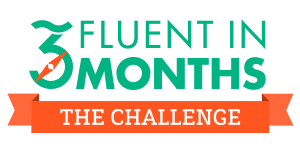 My main tool for learning Spanish will be The Fluent in 3 Months Challenge. This is a 90-day course that comes with a promise that I’ll have a 15-minute conversation in Spanish at the end of it.
My main tool for learning Spanish will be The Fluent in 3 Months Challenge. This is a 90-day course that comes with a promise that I’ll have a 15-minute conversation in Spanish at the end of it.Now I should say that the Fi3M Challenge isn’t a traditional Spanish course. It’s a method for rapid language learning that shows you, step-by-step, how to learn a new language in 90 days. It’s incredibly effective, but you do have to put the work in!
There are five Spanish modules included as part of Fi3M Challenge, to get you up to speed fast. But you’re also recommended other tools to use, too -- so I’ve shared what else I’m using below.
2. LingQ -- for Reading Stories in Spanish
 At least three days a week, I will read in Spanish using
LingQ
. I usually read books in French every night using this application. So, it will be easy to add Spanish to this developed habit. This is the fastest way for me to learn vocabulary.
At least three days a week, I will read in Spanish using
LingQ
. I usually read books in French every night using this application. So, it will be easy to add Spanish to this developed habit. This is the fastest way for me to learn vocabulary.I will start with short beginner stories but quickly move onto books. You see, I’m not a fan of short stories in my native language. So why would I like them in my target language?
Except for Tolstoy and J.D. Salinger. Those two knew how to write captivating short stories.
The Linguist by Steve Kaufman is available in audio and text on LingQ. That will be my first book in Spanish as I already read it in French. So, I’m familiar with the text.
3. Instagram -- I’ll be Writing One Instagram Post per Week
 I created an Instagram account for learning Spanish and will post once per week in my target language. I did this for French with excellent results.
I created an Instagram account for learning Spanish and will post once per week in my target language. I did this for French with excellent results.I will also comment on one or two posts that others write in Spanish.
4. Spanish Uncovered -- For Learning the Basics
 To learn Spanish grammar, I’ll be using
Spanish Uncovered
by Olly Richards, I will work through this beginner’s Spanish course at least three times per week. And I’ll be writing a review of this course at the end of the 90 days!
To learn Spanish grammar, I’ll be using
Spanish Uncovered
by Olly Richards, I will work through this beginner’s Spanish course at least three times per week. And I’ll be writing a review of this course at the end of the 90 days!5. YouTube -- Recording Myself Speaking Spanish
 I hate doing this one. I’m not of the YouTube generation. I live in mortal fear that my laptop will be stolen. My bedhead recordings will get leaked to the public.
I hate doing this one. I’m not of the YouTube generation. I live in mortal fear that my laptop will be stolen. My bedhead recordings will get leaked to the public.Videos of me looking like an extra on The Walking Dead will go viral. Children will recognize me while I’m walking in town. They’ll cling to their mothers screaming, “Mommy! Mommy! The YouTube zombie is here. Save me!”
Harsh lighting plus puffy morning eyes can get scary.
Seriously though, making videos is hard. Especially in another language. But it’s required as part of the Fi3M Challenge, and it’s one of the reasons the Challenge is so effective.
The practice of recording myself speaking helps move passive vocabulary to the speech centers in my brain. Yes, it is as painful as it sounds. But necessary.
Also, I’ve made my husband promise to melt my laptop into tiny buttons to save my afterlife pride. Reuse and recycle, people!
6. More LingQ! This Time for Listening to Spanish
 Using LingQ again, I will listen to short beginner conversations and an audiobook in Spanish. Most of my listening will take place while washing the dishes, driving, walking around the neighborhood and doing laundry.
Using LingQ again, I will listen to short beginner conversations and an audiobook in Spanish. Most of my listening will take place while washing the dishes, driving, walking around the neighborhood and doing laundry.This is a habit I created several months ago to improve my French hearing comprehension. The results amazed me. Such little effort involved!
7. italki -- for Speaking Spanish in Real Conversations
 With italki teachers, I plan on speaking 90 minutes per week. That could be three half-hour sessions per week. Or I might get wild and crazy with two 45-minute lessons per week.
With italki teachers, I plan on speaking 90 minutes per week. That could be three half-hour sessions per week. Or I might get wild and crazy with two 45-minute lessons per week.I will ask my teacher to only speak Spanish to me. This is super uncomfortable at first. But I’ve found it gives me the best results in the shortest amount of time.
I will only be using tutors this time, not language exchange partners. I have three language exchange partners in French. That’s how I will keep my French in working order during this mission.
8. Duolingo -- For Learning New Spanish Vocab
 The green owl was my main squeeze during the first month of learning French. It’s easy for days when I’m tired. It’s gamified for days when I’m feeling stubbornly adolescent. It takes less than five minutes when I need a quick win.
The green owl was my main squeeze during the first month of learning French. It’s easy for days when I’m tired. It’s gamified for days when I’m feeling stubbornly adolescent. It takes less than five minutes when I need a quick win.9. Coffee Break Spanish -- For When I Need a Break!
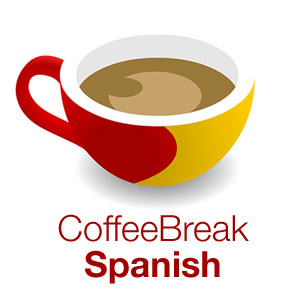 Mark Pendleton, the host of Coffee Break, was my buddy during my French journey. I’m grateful to have him along for my Spanish escapade as well. Because this podcast is mostly in English, I can use it on days when Spanish feels too overwhelming and I need a break.
Mark Pendleton, the host of Coffee Break, was my buddy during my French journey. I’m grateful to have him along for my Spanish escapade as well. Because this podcast is mostly in English, I can use it on days when Spanish feels too overwhelming and I need a break.10. Television -- at Least 100 Minutes of Spanish TV per Week
This is an easy one for me as my TV time is in French. I’ll swap out my French watching with Spanish. It’s back to the basics for me.
I will be watching things on Netflix with Spanish dubbing and Spanish subtitles until I get a feel for the language. I use this link to find Netflix shows that come in my target language.
For now, I will be rewatching shows that I’ve seen in French because it will be easier to follow and learn new words. Starting with The Good Place and Grace and Frankie.
I like shows that have an easy plot, and that I’ve watched before. I like shows that have a lot of episodes and that don’t curse a lot. I have quite a mouth on me if I stub my toe, so I have no need for more swear words in another language.
Am I Bad at Math?
If you added up my tools, you’ll notice that they amount to over 300 minutes per week. However, my Fi3M Challenge commitment is 225 minutes per week. So what gives?
My Fi3M Challenge commitment is the bare minimum. If I do that, I’m happy.
My tools are a roadmap of different aspects of the language I’d like to visit each week. I usually hit these goals because the sessions are short. I stack my session onto other habits.
For example, I will listen to Coffee Break Spanish while exercising.
To be honest, I have a solid routine in place. So, the time commitment is easy for me to achieve. Left to my own devices, I would only do the things I love and skip the things I need. That’s where the tools keep my learning balanced.
That’s It For Now! More Spanish Updates from Me Very Soon
That’s about it for my planning stage. I hope you found this article helpful. Maybe you’re planning on trying some of these tools. Maybe you have a few that you just love. Let us know in the comments! After all, sharing is caring.
In my next post, I’ll share my budding relationship with Spanish. Ahhh, my Spanish honeymoon! I sure hope it doesn’t rain.
I’ll also be giving you a sneak peek at how little I know in Spanish with my Day 0 video. Trust me. It’ll be short.
I wouldn’t mind some cyber-support. Cheer me on in the comments. And let me know what language you want to learn. Who knows! You might be the next person writing a three-month mission article.
The post New Mission! Elizabeth is Learning Spanish in 3 Months appeared first on Fluent in 3 months - Language Hacking and Travel Tips.




September 1, 2019
5 Reasons I Wish I Had Done the Add1Challenge 2 Years Ago (Language Learning in 90 Days)

“Am I a French Speaker or French Learner?”
Me: They wrote under my name that I speak French. Do you think that’s a valid statement? If you met me on the street would you consider me a person that speaks French or is learning to speak French?
Gillian: I recently described you as “my friend who speaks French”. You are missing a few vocabulary words that a native speaker would have. Yet, that doesn’t stop you from expressing yourself. Plus, we’re having this conversation in French right now.
(We both break into laughter at this hilarious but important observation.)
It’s such a gift to have a community of language learners who help me when I stumble. And hold me up when I’m feeling tender about my progress.
This wasn’t always the case.
It took me months of studying alone before I cobbled together a beautiful community. And now, I don’t know where I’d be without them.
If only there was an easier way!
Well, there is and I just finished my first go of it. It’s called Add1 and it’s everything I wish I had when I first started language learning.
In this article, I’m going to share five reasons I wish I discovered Add1 two years ago. But first, let me tell you about my LLEs.
What on Earth Are LLEs?
My poor italki tutor.
Every three months or so, I would suffer a Language Learning Emergency (LLE). It’s like a mid-life crisis only it revolved around my language learning progress.
And it was happening way too often.
Looking back, I see that I was missing three necessary aspects for success. Realistic goals. Community. Guidance.
My First Language Learning Emergency Happened Around Month Two
I was plodding right along with my 60-day streak on Duolingo and my weekly italki lessons when panic hit. A dark cloud appeared over my head and I was convinced that I was doing it all wrong.
Me: I don’t think I’m making progress. I might be your worst student ever. I’m learning words on Duolingo but I can’t understand anything on TV in French.
Tutor: I see your progress. You can answer most of my questions. Watching TV in French with French subtitles would be a good exercise for you. You need 300 hours of TV to be able to understand your target language. Continues comme ça (“Continue like this”).
And so, I whipped out my French notebook and created a bullet journal page that tracks how many hours I watch of French TV.
I started the Netflix series, Heartland. In French with French subtitles. It had a ton of seasons available and the sentences were simple.
It was exhausting.
My brain hurt afterwards and I only picked up ten percent of what was being said.
It Was the Beginning of My Dark Forest Days
I had two months of steady language learning under my belt. I didn’t want to lose the momentum but I was bored with my routine.
My biggest fear was that I would give up like I had the previous ten times.

It was freaking lonely.
At the time, I was the only person I knew in my tribe that was learning a second language. Oh sure, everyone I knew wanted to learn a language someday but no one was in the dark forest with me.
My second big LLE happened around month four.
I was drained from watching TV and stumbling through conversations. It felt like my brain was getting sucked out of my head and into Duolingo.
It was time for another revelatory talk with my tutor.
Me: I’m worried that I’m not doing this right. It takes me forever to find a French word in my brain and then actually use it in a sentence. How am I ever going to reach an intermediate B2 level?
Tutor (Slightly annoyed that I broke out of our French lesson AGAIN to voice my concerns in English): Have you tried recording yourself? That might be a good way to gain access to the words you’ve memorized. Continues comme ça.
With serious bedhead and lighting so awful I looked like Gollum from Lord of the Rings, I began recording myself speaking. Five minutes every few days.
My tutor was right. That practice helped me change passive vocabulary into active vocabulary and then…
Lightning Strikes a Third Time!
I was making weekly goals. Changing my tools every twelve weeks to keep my brain interested. And yet...
WHAMMO! LLE Number Three - I was worried that I was on the wrong path.
Me: I’ve read eight books in French now. Eight whole books! But shouldn’t I be farther along by now. I mean, I can watch TV in French without subtitles but I only understand about 40% and I’m reading a lot of body language. Don’t you think I should be going faster?
Tutor: (Stifling a yawn.) Elizabeth, learning a language takes years. Continues comme ça.
To this day, I get a weird facial tic if I hear someone say, “Continues comme ça.” It’s almost as annoying as someone shouting at you “RELAX!” when you’re stressed out. Almost.
You see, my tutor was not a certified marriage and family counselor. She wasn’t even a language coach.
She didn’t know how to help me navigate my feelings around language learning. I was struggling with the precipice of failure. She only knew how to practice French with me.
That’s not all that’s needed for the long, windy road to fluency.
What I needed was a coach but they can be expensive. And I wasn’t willing to dip into my exterior house painting fund. That wouldn’t have been fair to my husband.
He had compromised enough of his TV time to French. I couldn’t take away his dreams of a cheery yellow house. So, I trudged along with my periodic existential freakouts.
Until I found Add1.
Here are the five reasons I wish I took Add1 when I first started learning a language.
Reason Number 1: Navigation Through the Dark Forest of Language Learning

With Add1, I’m finally able to have in-depth conversations about language learning.
I even have one-on-one access to a personal coach. Not an exasperated tutor. A globe-trotting polyglot of a coach!
Shannon, the Head Coach of Add1 speaks eight languages to an advanced level and she’s learning more. So, she’s not far removed from language learning.
She is right there in the arena with us. Building vocabulary, using hacks, working through her first sentences.
Along with the Head Coach, I also have a group of dedicated polyglots who are taking the challenge with me.
I learn more from them than any social media language group.
They know me now. They share their experience of how to climb out of learning pitfalls.
In this video, I give an example of one of my most dreaded pitfalls - Comfy Sweatpants!
httpvh://www.youtube.com/watch?v=Gi2R8kFd1jE
Reason Number Two: Toned “Grit Muscles”
Right off the bat, you are required to flex your grit muscle. Every Add1er makes a baseline video of what they currently know in their target language.
Even if it’s only three words. Even if you don’t want to show yourself on camera. (Some people point the camera at a blank wall while talking.) Even if you have no idea what you’re going to say.
You’d think this would be a piece of cake for an intermediate speaker like me. Well, it wasn’t.
It did help that everyone else was flexing their grit muscle at the same time as me. With differing levels of discomfort. I was no longer alone.
Here’s a quick video where I share about one of my fears in language learning.
httpvh://www.youtube.com/watch?v=El0s0Xd4gLk
Reason Number Three: Accountability Helps Me Keep My Promises
Two years ago, I used social media for accountability. It’s hard when you don’t know who you’re talking to on Facebook, Instagram or Twitter. And it’s easy to disappear unnoticed.
I used my personal Facebook account as my very first accountability tool.
My first post was how I had been learning French for 20 days. A French waiter was so good-natured. I took what felt like thirty minutes to order a coffee in my target language.
My enthusiasm was contagious and he insisted that my husband take a picture of us together. It felt like a real win.
Because I shared this on Facebook, I got serotonin hits with each “like” and it helped me continue. However, my FB feed was getting old fast. How many times can I describe the number of days I’ve been studying or the amount of words I learned.
What made it worse is that only one friend in my Facebook world was learning a language.
Most of the comments on my posts were, “Oh, I’ve always wanted to learn another language but I’m too busy.”
I’ll forever be grateful to the words of encouragement. But, it felt lonely to be the only one sharing about language learning. I didn’t have anyone to trade ideas with or understand my small but mighty successes.
A year of increasingly isolating posts later, I learned about language specific accounts. Now I use instagram as a French only account which is way more powerful. It took quite a few weeks of introducing myself to build a lasting community but I finally did.
The Add1 community has a similar energy to people at their favorite rock concert. Only it’s for uber-cool language nerds like me. Relationships with other learners deepen as we learn and grow together.
A Strong Community Means No More Disappearing Act
Unlike my social media community, I couldn’t do a disappearing act.

Members of my Add1 tribe would message me if I hadn’t checked in. It reminded me of being on a hike with friends. Nobody gets left behind.
There are tools in place to keep you from doing magic tricks with your language goals. The only things getting pulled out of a hat are solution-oriented steps. The progression of assignments kept me from resting on my laurels.
Reason Number Four: Add1 Tracks Measurable Progress
Seeing how far you’ve come is a great way to stay motivated. Add1 offers a number of ways to track your progress. Here are a few of my favorites.
Daily Development Journal
New Sentence Tally
Inspiration Tracker
Speaking Record
Grit Accounting
Creativity Log
Question/Answer Listing
Reflection Register
Celebration Station
The Add1 path includes assignments, mini-challenges, Dream Team meetings and tracking. These tools keep learning pleasant and fresh.
Reason Number Five: Deep Diving Community with a Defined Goal
At the end of the day, what really matters is connection. The secret to my successful French odyssey is simple. It is my desire to connect with people who speak French.
What keeps me coming back to my study nook month after month after month are my newfound friendships.
I enjoy my weekly Google Hangout meetings with my Add1 Dream Team. I relish in catching up with my Add1 friends on our private online community. I look forward to celebrating the successes of my fellow learners.
It warms my heart to see a beginner record himself in French and receive kind comments and fun emojis.
I finally have a supportive community.
Add1 Was an Essential Part of My French Routine.
My goal was to solidify my spoken French before the end of the challenge.
Why? Because I’m taking the next Add1 in Spanish as a brand spanking new beginner. I want to be sure my French is solid before I begin.
And that goal has been realized!
Here’s a video on my victory over a dreaded fossilized error.
httpvh://www.youtube.com/watch?v=y_JiEX1YWYw
I have a sneaking suspicion that my italki tutor is privately be doing cartwheels. Because I no longer have language freak-outs on a regular basis. She was happy to learn that I’m working with a language coach to help calm the painful LLEs.

I am more secure in my language learning. And I am saving my tutor headaches due to eye-roll fatigue. Thanks to Add1, I can confidently say, “I am a French speaker.”
If I Had Found Add1 on Week One of My Language Expedition...
I would have jumped over many of the hurdles that nearly stopped me.
Don’t get me wrong. I’m grateful for my muddy, messy path. If I didn’t have it, I would have nothing of interest to share with you.
I’m grateful you can learn from my mistakes.
But I’m also hoping you will have an easier time of it.
Who knows! Maybe you’ll even join me for the next Add1. How fun would that be?!
Wishing You Much Peace on Your Language Learning Journey.
Please be kind to yourself. You’ll travel a greater distance that way.
I’d love to hear about your language learning emergencies. What hurdles did you overcome? How did you do it? Please share it in the comments.
The post 5 Reasons I Wish I Had Done the Add1Challenge 2 Years Ago (Language Learning in 90 Days) appeared first on Fluent in 3 months - Language Hacking and Travel Tips.




5 Reasons I Wish I Had Done Add1 2 Years Ago (Language Learning in 90 Days)

“Am I a French Speaker or French Learner?”
Me: They wrote under my name that I speak French. Do you think that’s a valid statement? If you met me on the street would you consider me a person that speaks French or is learning to speak French?
Gillian: I recently described you as “my friend who speaks French”. You are missing a few vocabulary words that a native speaker would have. Yet, that doesn’t stop you from expressing yourself. Plus, we’re having this conversation in French right now.
(We both break into laughter at this hilarious but important observation.)
It’s such a gift to have a community of language learners who help me when I stumble. And hold me up when I’m feeling tender about my progress.
This wasn’t always the case.
It took me months of studying alone before I cobbled together a beautiful community. And now, I don’t know where I’d be without them.
If only there was an easier way!
Well, there is and I just finished my first go of it. It’s called Add1 and it’s everything I wish I had when I first started language learning.
In this article, I’m going to share five reasons I wish I discovered Add1 two years ago. But first, let me tell you about my LLEs.
What on Earth Are LLEs?
My poor italki tutor.
Every three months or so, I would suffer a Language Learning Emergency (LLE). It’s like a mid-life crisis only it revolved around my language learning progress.
And it was happening way too often.
Looking back, I see that I was missing three necessary aspects for success. Realistic goals. Community. Guidance.
My First Language Learning Emergency Happened Around Month Two
I was plodding right along with my 60-day streak on Duolingo and my weekly italki lessons when panic hit. A dark cloud appeared over my head and I was convinced that I was doing it all wrong.
Me: I don’t think I’m making progress. I might be your worst student ever. I’m learning words on Duolingo but I can’t understand anything on TV in French.
Tutor: I see your progress. You can answer most of my questions. Watching TV in French with French subtitles would be a good exercise for you. You need 300 hours of TV to be able to understand your target language. Continues comme ça (“Continue like this”).
And so, I whipped out my French notebook and created a bullet journal page that tracks how many hours I watch of French TV.
I started the Netflix series, Heartland. In French with French subtitles. It had a ton of seasons available and the sentences were simple.
It was exhausting.
My brain hurt afterwards and I only picked up ten percent of what was being said.
It Was the Beginning of My Dark Forest Days
I had two months of steady language learning under my belt. I didn’t want to lose the momentum but I was bored with my routine.
My biggest fear was that I would give up like I had the previous ten times.

It was freaking lonely.
At the time, I was the only person I knew in my tribe that was learning a second language. Oh sure, everyone I knew wanted to learn a language someday but no one was in the dark forest with me.
My second big LLE happened around month four.
I was drained from watching TV and stumbling through conversations. It felt like my brain was getting sucked out of my head and into Duolingo.
It was time for another revelatory talk with my tutor.
Me: I’m worried that I’m not doing this right. It takes me forever to find a French word in my brain and then actually use it in a sentence. How am I ever going to reach an intermediate B2 level?
Tutor (Slightly annoyed that I broke out of our French lesson AGAIN to voice my concerns in English): Have you tried recording yourself? That might be a good way to gain access to the words you’ve memorized. Continues comme ça.
With serious bedhead and lighting so awful I looked like Gollum from Lord of the Rings, I began recording myself speaking. Five minutes every few days.
My tutor was right. That practice helped me change passive vocabulary into active vocabulary and then…
Lightning Strikes a Third Time!
I was making weekly goals. Changing my tools every twelve weeks to keep my brain interested. And yet...
WHAMMO! LLE Number Three - I was worried that I was on the wrong path.
Me: I’ve read eight books in French now. Eight whole books! But shouldn’t I be farther along by now. I mean, I can watch TV in French without subtitles but I only understand about 40% and I’m reading a lot of body language. Don’t you think I should be going faster?
Tutor: (Stifling a yawn.) Elizabeth, learning a language takes years. Continues comme ça.
To this day, I get a weird facial tic if I hear someone say, “Continues comme ça.” It’s almost as annoying as someone shouting at you “RELAX!” when you’re stressed out. Almost.
You see, my tutor was not a certified marriage and family counselor. She wasn’t even a language coach.
She didn’t know how to help me navigate my feelings around language learning. I was struggling with the precipice of failure. She only knew how to practice French with me.
That’s not all that’s needed for the long, windy road to fluency.
What I needed was a coach but they can be expensive. And I wasn’t willing to dip into my exterior house painting fund. That wouldn’t have been fair to my husband.
He had compromised enough of his TV time to French. I couldn’t take away his dreams of a cheery yellow house. So, I trudged along with my periodic existential freakouts.
Until I found Add1.
Here are the five reasons I wish I took Add1 when I first started learning a language.
Reason Number 1: Navigation Through the Dark Forest of Language Learning

With Add1, I’m finally able to have in-depth conversations about language learning.
I even have one-on-one access to a personal coach. Not an exasperated tutor. A globe-trotting polyglot of a coach!
Shannon, the Head Coach of Add1 speaks eight languages to an advanced level and she’s learning more. So, she’s not far removed from language learning.
She is right there in the arena with us. Building vocabulary, using hacks, working through her first sentences.
Along with the Head Coach, I also have a group of dedicated polyglots who are taking the challenge with me.
I learn more from them than any social media language group.
They know me now. They share their experience of how to climb out of learning pitfalls.
In this video, I give an example of one of my most dreaded pitfalls - Comfy Sweatpants!
httpvh://www.youtube.com/watch?v=Gi2R8kFd1jE
Reason Number Two: Toned “Grit Muscles”
Right off the bat, you are required to flex your grit muscle. Every Add1er makes a baseline video of what they currently know in their target language.
Even if it’s only three words. Even if you don’t want to show yourself on camera. (Some people point the camera at a blank wall while talking.) Even if you have no idea what you’re going to say.
You’d think this would be a piece of cake for an intermediate speaker like me. Well, it wasn’t.
It did help that everyone else was flexing their grit muscle at the same time as me. With differing levels of discomfort. I was no longer alone.
Here’s a quick video where I share about one of my fears in language learning.
httpvh://www.youtube.com/watch?v=El0s0Xd4gLk
Reason Number Three: Accountability Helps Me Keep My Promises
Two years ago, I used social media for accountability. It’s hard when you don’t know who you’re talking to on Facebook, Instagram or Twitter. And it’s easy to disappear unnoticed.
I used my personal Facebook account as my very first accountability tool.
My first post was how I had been learning French for 20 days. A French waiter was so good-natured. I took what felt like thirty minutes to order a coffee in my target language.
My enthusiasm was contagious and he insisted that my husband take a picture of us together. It felt like a real win.
Because I shared this on Facebook, I got serotonin hits with each “like” and it helped me continue. However, my FB feed was getting old fast. How many times can I describe the number of days I’ve been studying or the amount of words I learned.
What made it worse is that only one friend in my Facebook world was learning a language.
Most of the comments on my posts were, “Oh, I’ve always wanted to learn another language but I’m too busy.”
I’ll forever be grateful to the words of encouragement. But, it felt lonely to be the only one sharing about language learning. I didn’t have anyone to trade ideas with or understand my small but mighty successes.
A year of increasingly isolating posts later, I learned about language specific accounts. Now I use instagram as a French only account which is way more powerful. It took quite a few weeks of introducing myself to build a lasting community but I finally did.
The Add1 community has a similar energy to people at their favorite rock concert. Only it’s for uber-cool language nerds like me. Relationships with other learners deepen as we learn and grow together.
A Strong Community Means No More Disappearing Act
Unlike my social media community, I couldn’t do a disappearing act.

Members of my Add1 tribe would message me if I hadn’t checked in. It reminded me of being on a hike with friends. Nobody gets left behind.
There are tools in place to keep you from doing magic tricks with your language goals. The only things getting pulled out of a hat are solution-oriented steps. The progression of assignments kept me from resting on my laurels.
Reason Number Four: Add1 Tracks Measurable Progress
Seeing how far you’ve come is a great way to stay motivated. Add1 offers a number of ways to track your progress. Here are a few of my favorites.
Daily Development Journal
New Sentence Tally
Inspiration Tracker
Speaking Record
Grit Accounting
Creativity Log
Question/Answer Listing
Reflection Register
Celebration Station
The Add1 path includes assignments, mini-challenges, Dream Team meetings and tracking. These tools keep learning pleasant and fresh.
Reason Number Five: Deep Diving Community with a Defined Goal
At the end of the day, what really matters is connection. The secret to my successful French odyssey is simple. It is my desire to connect with people who speak French.
What keeps me coming back to my study nook month after month after month are my newfound friendships.
I enjoy my weekly Google Hangout meetings with my Add1 Dream Team. I relish in catching up with my Add1 friends on our private online community. I look forward to celebrating the successes of my fellow learners.
It warms my heart to see a beginner record himself in French and receive kind comments and fun emojis.
I finally have a supportive community.
Add1 Was an Essential Part of My French Routine.
My goal was to solidify my spoken French before the end of the challenge.
Why? Because I’m taking the next Add1 in Spanish as a brand spanking new beginner. I want to be sure my French is solid before I begin.
And that goal has been realized!
Here’s a video on my victory over a dreaded fossilized error.
httpvh://www.youtube.com/watch?v=y_JiEX1YWYw
I have a sneaking suspicion that my italki tutor is privately be doing cartwheels. Because I no longer have language freak-outs on a regular basis. She was happy to learn that I’m working with a language coach to help calm the painful LLEs.

I am more secure in my language learning. And I am saving my tutor headaches due to eye-roll fatigue. Thanks to Add1, I can confidently say, “I am a French speaker.”
If I Had Found Add1 on Week One of My Language Expedition...
I would have jumped over many of the hurdles that nearly stopped me.
Don’t get me wrong. I’m grateful for my muddy, messy path. If I didn’t have it, I would have nothing of interest to share with you.
I’m grateful you can learn from my mistakes.
But I’m also hoping you will have an easier time of it.
Who knows! Maybe you’ll even join me for the next Add1. How fun would that be?!
Wishing You Much Peace on Your Language Learning Journey.
Please be kind to yourself. You’ll travel a greater distance that way.
I’d love to hear about your language learning emergencies. What hurdles did you overcome? How did you do it? Please share it in the comments.
The post 5 Reasons I Wish I Had Done Add1 2 Years Ago (Language Learning in 90 Days) appeared first on Fluent in 3 months - Language Hacking and Travel Tips.







